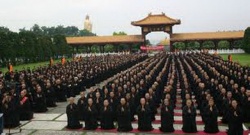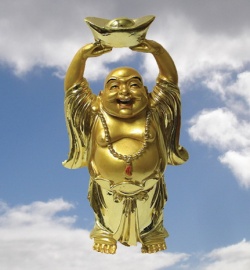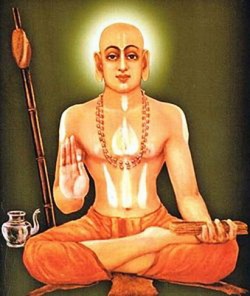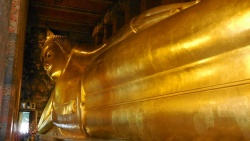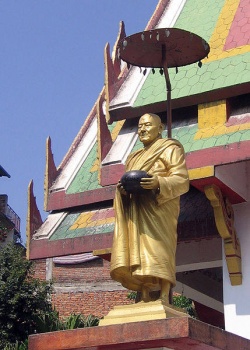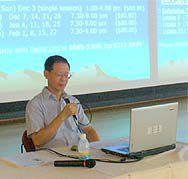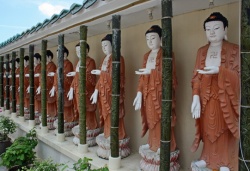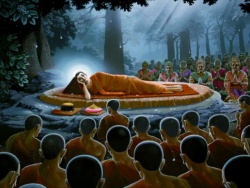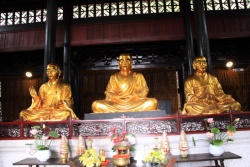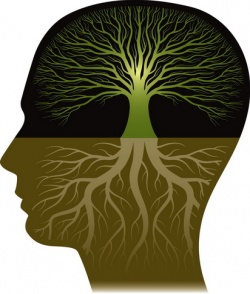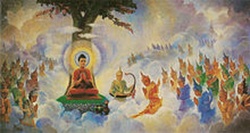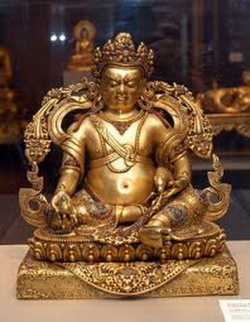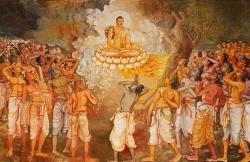Difference between revisions of "The Ironic Assumptions of Gregory Schopen"
(Created page with "thumb|250px| <poem> Introduction The methods and assumptions of Buddhist text-critical studies have come under challenge, indeed front...") |
m (Text replacement - "]]]" to "]])") |
||
| (16 intermediate revisions by 4 users not shown) | |||
| Line 3: | Line 3: | ||
Introduction | Introduction | ||
| − | The methods and assumptions of Buddhist text-critical studies have come under challenge, indeed frontal assault, by the influential academic Gregory Schopen. His writings are deliberately provocative and sometimes brilliant. His basic approach in understanding Indian Buddhism may be summed up as a change in method, leading to different results. | + | The methods and assumptions of [[Buddhist]] text-critical studies have come under challenge, indeed frontal assault, by the influential academic [[Gregory Schopen]]. His writings are deliberately provocative and sometimes brilliant. His basic approach in understanding [[Indian Buddhism]] may be summed up as a change in method, leading to different results. |
| − | In method, he criticizes the assumption of modern scholars that the study of Buddhism may be equated with the study of its texts, and instead proposes that the archaeological evidence should be granted priority. I think all would agree that he has a point here, but it is not obvious to me that previous scholars have been so negligent in this regard. As just one random example, Lamotte’s discussion of King Milinda occupies about seven pages.1 The first three pages mainly survey the evidences of the coins and other material evidence, summed up as ‘as few fragmentary inscriptions’; the next three pages discuss the Milindapañha, an important work of the Middle Period preserved in Chinese and Pali; and the final page mentions a few references in later works. This seems reasonable to me; if anything I would have liked to see more discussion of some of the philosophical points raised in the Milindapañha, whose stance tends to be intermediate between the | + | In method, he criticizes the assumption of modern scholars that the study of [[Buddhism]] may be equated with the study of its texts, and instead proposes that the archaeological evidence should be granted priority. I think all would agree that he has a point here, but it is not obvious to me that previous scholars have been so negligent in this regard. As just one random example, Lamotte’s discussion of [[King Milinda]] occupies about seven pages.1 The first three pages mainly survey the evidences of the coins and other material evidence, summed up as ‘as few fragmentary inscriptions’; the next three pages discuss the [[Milindapañha]], an important work of the Middle Period preserved in {{Wiki|Chinese}} and [[Pali]]; and the final page mentions a few references in later works. This seems reasonable to me; if anything I would have liked to see more discussion of some of the philosophical points raised in the [[Milindapañha]], whose stance tends to be intermediate between the [[canon]]ical doctrines and the developed positions of the schools. |
| − | As far as the results of research are concerned, Schopen says that the record of the bones and stones depicts a very different type of Buddhist monastic, one who is more worldly and human than the caricature of the ascetic hero striving for Nibbana alone in the forest. | + | As far as the results of research are concerned, [[Schopen]] says that the record of the {{Wiki|bones}} and stones depicts a very different type of [[Buddhist]] monastic, one who is more [[worldly]] and [[human]] than the caricature of the [[ascetic]] [[hero]] striving for [[Nibbana]] alone in the {{Wiki|forest}}. |
| − | What Schopen gets right | + | What [[Schopen]] gets right |
[[File:Taiwan Today.jpg|thumb|250px|]] | [[File:Taiwan Today.jpg|thumb|250px|]] | ||
| − | Many of Schopen’s conclusions, I think, are obviously true. He is primarily interested in the ‘Middle Period’ of Indian Buddhism, that is, the five hundred years or so from the beginning of the Common Era. He uses the remnants of monasteries, stupas, graves, etc., together with Vinaya material, primarily from the Mūlasarvāstivāda Vinaya in Tibetan (he makes little use of the Chinese sources), which he says stems from the same period and depicts much the same activity. These sources speak to us of monks and nuns who accumulate wealth, make substantial donations from their own wealth for building projects, promote devotional activity such as worship of stupas, images, and relics, are engaged in business transactions, contracts, and lending on interest, and are frequently at the beck and call of the lay followers for | + | Many of [[Schopen’s]] conclusions, I think, are obviously true. He is primarily interested in the ‘Middle Period’ of [[Indian Buddhism]], that is, the five hundred years or so from the beginning of the Common {{Wiki|Era}}. He uses the remnants of monasteries, [[stupas]], graves, etc., together with [[Vinaya]] material, primarily from the [[Mūlasarvāstivāda]] [[Vinaya]] in [[Tibetan]] (he makes little use of the {{Wiki|Chinese}} sources), which he says stems from the same period and depicts much the same activity. These sources speak to us of [[monks and nuns]] who accumulate [[wealth]], make substantial donations from their [[own]] [[wealth]] for building projects, promote devotional activity such as worship of [[stupas]], images, and [[relics]], are engaged in business transactions, contracts, and lending on [[interest]], and are frequently at the beck and call of the lay followers for per[[form]]ance of [[rituals]] such as weddings, house blessing, and so on. All of this picture is quite convincing and needs little discussion here. |
| − | But while it is obviously true, I would also contend that it is truly obvious. All the activities that Schopen depicts may be plainly seen in the activities of the majority of the ordained Sangha in all traditions in the present day. Schopen merely points out that these conditions also obtained in the Middle Period of Indian Buddhism as well. While this may come as a surprise to academics with little contact with Buddhism in the real world, and constitutes an important critique of the fallacy of equating Buddhism with the idealized portrait in the sacred texts, it will come as no surprise for those of us who encounter Buddhism in the world every day. | + | But while it is obviously true, I would also contend that it is truly obvious. All the activities that [[Schopen]] depicts may be plainly seen in the activities of the majority of the [[ordained]] [[Sangha]] in all traditions in the {{Wiki|present}} day. [[Schopen]] merely points out that these conditions also obtained in the Middle Period of [[Indian Buddhism]] as well. While this may come as a surprise to academics with little contact with [[Buddhism]] in the real [[world]], and constitutes an important critique of the fallacy of equating [[Buddhism]] with the idealized portrait in the sacred texts, it will come as no surprise for those of us who encounter [[Buddhism]] in the [[world]] every day. |
[[File:Sky-la.jpg|thumb|250px|]] | [[File:Sky-la.jpg|thumb|250px|]] | ||
| − | Another of Schopen’s arguments that is well taken is that the average monk or nun, not to speak of the lay followers, may hardly even know of the scriptural texts. The scriptures may have only been known to a small elite of scholars, and the ideas therein might not be representative of the range of Buddhists. A few years ago I was staying in a forest hut belonging to a devoted, intelligent Thai Buddhist, who, when he was young, had been in robes for two and a half years. Once I visited a local monastery and borrowed copies of some of the Suttas. When I mentioned it to my friend, he looked absolutely blank: he had never even heard the words | + | Another of [[Schopen’s]] arguments that is well taken is that the average [[monk]] or [[nun]], not to speak of the lay followers, may hardly even [[know]] of the scriptural texts. The scriptures may have only been known to a small {{Wiki|elite}} of scholars, and the [[ideas]] therein might not be representative of the range of [[Buddhists]]. A few years ago I was staying in a {{Wiki|forest}} hut belonging to a devoted, intelligent [[Thai]] [[Buddhist]], who, when he was young, had been in [[robes]] for two and a half years. Once I visited a local monastery and borrowed copies of some of the [[Suttas]]. When I mentioned it to my [[friend]], he looked absolutely blank: he had never even [[heard]] the words ‘[[Majjhima Nikāya]]’ or ‘[[Dīgha]] [[Nikāya]]’. Again it seems plausible that this situation, observable today, could have obtained two thousand years ago in [[India]]. But the argument should not be overstated. The [[Buddhist]] scriptures are big works. They must have required a substantial organization of monk-&-nun [[power]] to maintain, whether in oral [[form]] or even in the later written [[form]], and so a large number of [[people]] must have known them. The number of inscriptions from {{Wiki|ancient India}} is only a few thousand, and so can only represent a tiny fraction of scraps of [[ideas]] of all the [[Indian]] [[Buddhists]]. And those who are wealthy enough to donate religious monuments are hardly likely to be representative of the full spectrum of the [[Buddhist]] community. Anyway, as [[Schopen]] emphasizes, many of the donors are [[monks and nuns]] (according to [[Schopen]], most of the donors are monastic, and in the Middle period, about half the monastics are [[nuns]]) who [[state]] that they are versed in the ‘[[Suttas]]’ or ‘[[Vinaya]]’ or ‘[[Tripiṭaka]]’ or ‘[[Nikāyas]]’; in other words, they are the same [[people]] as those who passed down the [[scriptures]]. |
| − | ‘Protestant | + | ‘Protestant [[Buddhism]]’ and [[subjectivity]] |
| + | |||
| + | [[Schopen]] is scathing in his assessment of the ‘assumptions’ made by various [[Buddhist]] scholars. He characterizes the work of early, Victorian, scholars such as [[Oldenberg]] and Rhys Davids as ‘protestant’, and suggests that they have read their [[own]] biases into the [[Buddhist texts]], depicting the [[Buddha]] and his [[Sangha]] much like [[rational]], cultured {{Wiki|European}} gentlemen. | ||
| − | |||
[[File:Sri Madhvacharya.jpg|thumb|250px|]] | [[File:Sri Madhvacharya.jpg|thumb|250px|]] | ||
| − | This, too, is true, but it is hardly a valid criticism. Anyone familiar with Buddhist thought should accept that our understanding is always coloured by our beliefs and values. Fine, let’s point this out—but let’s not assume that we are an exception. I am a forest monk, and I believe that the Buddha and his early generations of ordained disciples were also forest monks and nuns. So when I look at the heritage of Buddhism, I naturally focus on this aspect. | + | This, too, is true, but it is hardly a valid criticism. Anyone familiar with [[Buddhist]] [[thought]] should accept that our understanding is always coloured by our [[beliefs]] and values. Fine, let’s point this out—but let’s not assume that we are an exception. I am a {{Wiki|forest}} [[monk]], and I believe that the [[Buddha]] and his early generations of [[ordained]] disciples were also {{Wiki|forest}} [[monks and nuns]]. So when I look at the heritage of [[Buddhism]], I naturally focus on this aspect. |
| − | Gregory Schopen is a highly paid academic from an overwhelmingly materialistic society, and so when he looks at the heritage of Buddhism he sees money, rocks, and material remains. When he does look at the texts—as any scholar, whatever their beliefs, must eventually do, for the information contained in the inscriptions is scanty—he focuses on the Vinayas, since they deal most directly with the material aspects of monastic life—buildings, etc. But the Vinayas themselves represent a movement from the spiritual to the material—they are about what monks and nuns do when they misbehave, and so taken by themselves they are misleading. We would not expect to gain an accurate vision of how an ordinary person leads their daily life today by reading law books. | + | [[Gregory Schopen]] is a highly paid academic from an overwhelmingly materialistic society, and so when he looks at the heritage of [[Buddhism]] he sees [[money]], rocks, and material remains. When he does look at the texts—as any [[scholar]], whatever their [[beliefs]], must eventually do, for the information contained in the inscriptions is scanty—he focuses on the [[Vinayas]], since they deal most directly with the material aspects of monastic life—buildings, etc. But the [[Vinayas]] themselves represent a movement from the spiritual to the material—they are about what [[monks and nuns]] do when they misbehave, and so taken by themselves they are misleading. We would not expect to gain an accurate vision of how an ordinary person leads their daily [[life]] today by reading law [[books]]. |
| − | Schopen contrasts the wealthy, developed monasteries with the poor, simple villages nearby. His agenda is, in the broadest sense, Marxist. I do not mean that in the slightest pejorative sense—I think it’s sweet that he dedicates his books to the ‘working men and women’ whose ‘labor paid for my scholarly leisure’. But he has little interest in the spiritual aspect of Buddhism, which puts him in a minority of those, at any time, who wish to learn the Dhamma. | + | [[Schopen]] contrasts the wealthy, developed monasteries with the poor, simple villages nearby. His agenda is, in the broadest [[sense]], Marxist. I do not mean that in the slightest pejorative sense—I think it’s [[sweet]] that he dedicates his [[books]] to the ‘working men and women’ whose ‘labor paid for my scholarly leisure’. But he has little [[interest]] in the spiritual aspect of [[Buddhism]], which puts him in a minority of those, at any [[time]], who wish to learn the [[Dhamma]]. |
| − | It should be obvious that Schopen’s assumptions influence his conclusions, just as the assumptions of earlier scholars influence their conclusions. Wholesome states of mind leave no scar on the rocks. Meditation attainments are | + | It should be obvious that [[Schopen’s]] assumptions influence his conclusions, just as the assumptions of earlier scholars influence their conclusions. Wholesome states of [[mind]] leave no scar on the rocks. Meditation attainments are [[air]]ily ephemeral. [[Insights]] into reality happen in the wispy [[world]] of the [[mind]]. If we were to accept [[Schopen’s]] methods unconditionally, we would have to abandon the very [[reason]] that most of us became interested in [[Buddhism]]. There would be no more [[reason]] to study {{Wiki|ancient India}} than any other {{Wiki|ancient}} culture. This may not be a problem for [[Schopen]], but it is a big one for most students of [[Buddhism]]. |
[[File:Reclinng-buddha1.jpg|thumb|250px|]] | [[File:Reclinng-buddha1.jpg|thumb|250px|]] | ||
| − | My primary interest is in spiritual practice, and my interest in the Āgama Suttas stems from this: they describe a spiritual practice that I find inspiring, practical, and profound. I have tried, to my limited best, to live up to the ideals taught in that literature, and have invariably found that, when problems arise, they are due to my own inadequacies, not those of the teachings. I have also had close contact with a number of human beings whose inner radiance testified to the power of the Dhamma when lived to its fullest. Since this tradition that I belong to claims to stem from a genuine historical individual called the Buddha, it is important to investigate what truth there might be to this claim. | + | My [[primary]] [[interest]] is in spiritual practice, and my [[interest]] in the [[Āgama]] [[Suttas]] stems from this: they describe a spiritual practice that I find inspiring, practical, and profound. I have tried, to my limited best, to [[live]] up to the ideals [[taught]] in that literature, and have invariably found that, when problems arise, they are due to my [[own]] inadequacies, not those of the teachings. I have also had close contact with a number of [[human beings]] whose inner radiance testified to the [[power]] of the [[Dhamma]] when lived to its fullest. Since this tradition that I belong to claims to stem from a genuine historical individual called the [[Buddha]], it is important to investigate what [[truth]] there might be to this claim. |
On the rhetoric of dates | On the rhetoric of dates | ||
| − | Schopen’s work contains much that is interesting and informative, but little that could be called inspiring. His writing is characterized by wit, scandal, and good yarns. Unfortunately, it is not always characterized by consistency, and we should examine some of his fracture lines. He rests his arguments heavily on the authority of the Mūlasarvāstivāda Vinaya, a text he cheerfully admits to not having fully read. This Vinaya is ‘monstrous’ in size, perhaps 4000 folios in the Tibetan, and most scholars have taken it to be late, perhaps 500 CE. Schopen would like to see this Vinaya dated earlier, around the beginning of the Common Era. On the other hand, the Theravāda Vinaya has been taken by most scholars to be early, but Schopen would also like to date that around the beginning of the Common Era. Thus the battle-lines are drawn. Schopen says that the discussion of the date of the Mūlasarvāstivāda Vinaya has been: | + | [[Schopen’s]] work contains much that is interesting and informative, but little that could be called inspiring. His writing is characterized by wit, scandal, and good yarns. Unfortunately, it is not always characterized by consistency, and we should examine some of his fracture lines. He rests his arguments heavily on the authority of the [[Mūlasarvāstivāda]] [[Vinaya]], a text he cheerfully admits to not having fully read. This [[Vinaya]] is ‘monstrous’ in size, perhaps 4000 folios in the [[Tibetan]], and most scholars have taken it to be late, perhaps 500 CE. [[Schopen]] would like to see this [[Vinaya]] dated earlier, around the beginning of the Common {{Wiki|Era}}. On the other hand, the [[Theravāda]] [[Vinaya]] has been taken by most scholars to be early, but [[Schopen]] would also like to date that around the beginning of the Common {{Wiki|Era}}. [[Thus]] the battle-lines are drawn. [[Schopen]] says that the discussion of the date of the [[Mūlasarvāstivāda]] [[Vinaya]] has been: |
| − | ‘… badly misdirected by a very red herring and the inattention of those who are supposed to be following the trail. In 1958 the great Belgian scholar Etienne Lamotte declared that this Vinaya, or code, was late, that “one cannot attribute to this work a date earlier than the 4th–5th centuries of the Christian Era.” This pronouncement—even at its inception based on very shaky grounds—still proved almost fatal, for Lamotte was forced by his own further work to change his position—and he did so several times—but few scholars seem to have noticed. By 1966, Lamotte was in fact referring to the Mūlasarvāstivāda Vinaya as a source of information for the first or second century of our era. Ironically, other scholars then, and for a long time after, continued to quote only the Lamotte of 1958.’2 | + | ‘… badly misdirected by a very red herring and the inattention of those who are supposed to be following the trail. In 1958 the great Belgian [[scholar]] {{Wiki|Etienne Lamotte}} declared that this [[Vinaya]], or code, was late, that “one cannot attribute to this work a date earlier than the 4th–5th centuries of the Christian {{Wiki|Era}}.” This pronouncement—even at its inception based on very shaky grounds—still proved almost fatal, for [[Wikipedia:Étienne Lamotte|Lamotte]] was forced by his [[own]] further work to change his position—and he did so several times—but few scholars seem to have noticed. By 1966, [[Wikipedia:Étienne Lamotte|Lamotte]] was in fact referring to the [[Mūlasarvāstivāda]] [[Vinaya]] as a source of information for the first or second century of our {{Wiki|era}}. Ironically, other scholars then, and for a long [[time]] after, continued to quote only the [[Wikipedia:Étienne Lamotte|Lamotte]] of 1958.’2 |
“ | “ | ||
[[File:Pragyananda statue.jpg|thumb|250px|]] | [[File:Pragyananda statue.jpg|thumb|250px|]] | ||
| − | I must also confess inattention, for I have not followed the trail of Lamotte’s arguments and so must declare my incompetence to pronounce on the date of the Mūlasarvāstivāda Vinaya. It might be noticed in passing, though, that the two positions ascribed to Lamotte in this passage are not necessarily contradictory. Given the evidently long period it would take to compile a vast compendium like the Mūlasarvāstivāda Vinaya, it is not unreasonable to maintain that the final redaction was in the 4th–5th centuries C.E., but that it contains material inherited from a much earlier time. In fact, something of this sort could be said for almost all Buddhist literature. This is a phenomenon known as ‘intratextuality’, the ongoing life of a given text through a particular stream of tradition, which reflects the conservative nature of religious literature: the redactors valued ancient authority over creative expression and thus tended to work with material already to hand rather than inventing new material.3 In any case, there is nothing ‘ironical’ in the failure of some writers to notice Lamotte’s change of views: if scholars continue to quote from earlier, discredited theories this is a mistake, not an irony. | + | I must also confess inattention, for I have not followed the trail of Lamotte’s arguments and so must declare my incompetence to pronounce on the date of the [[Mūlasarvāstivāda]] [[Vinaya]]. It might be noticed in passing, though, that the two positions ascribed to [[Wikipedia:Étienne Lamotte|Lamotte]] in this passage are not necessarily contradictory. Given the evidently long period it would take to compile a vast compendium like the [[Mūlasarvāstivāda]] [[Vinaya]], it is not unreasonable to maintain that the final redaction was in the 4th–5th centuries C.E., but that it contains material inherited from a much earlier [[time]]. In fact, something of this sort could be said for almost all [[Buddhist]] literature. This is a phenomenon known as ‘intratextuality’, the ongoing [[life]] of a given text through a particular {{Wiki|stream}} of tradition, which reflects the conservative [[nature]] of religious literature: the redactors valued {{Wiki|ancient}} authority over creative expression and thus tended to work with material already to hand rather than inventing new material.3 In any case, there is nothing ‘ironical’ in the failure of some writers to [[notice]] Lamotte’s change of [[views]]: if scholars continue to quote from earlier, discredited theories this is a mistake, not an irony. |
| − | An example of true irony could be better seen from | + | An example of true irony could be better seen from [[Schopen’]]s [[own]] work. In the same [[book]] as the above quote, he says this: |
| − | ‘… this literature, the Mūlasarvāstivāda Vinaya, is itself considered by many to be late—Lamotte, for example, thinks it is the latest of the vinayas and says “we cannot attribute to this work a date earlier than the fourth–fifth centuries of the Christian | + | ‘… this literature, the [[Mūlasarvāstivāda Vinaya]], is itself considered by many to be late—Lamotte, for example, [[thinks]] it is the latest of the [[vinayas]] and says “we cannot attribute to this work a date earlier than the fourth–fifth centuries of the Christian {{Wiki|Era}}” …’4 |
“ | “ | ||
| − | Note that here Schopen says that Lamotte | + | Note that here [[Schopen]] says that [[Wikipedia:Étienne Lamotte|Lamotte]] ‘[[thinks]]’ ({{Wiki|present}} tense), thus precluding any later change of [[mind]]. This clanger needs little comment, apart from reminding us that [[Schopen]], like the rest of us, is sometimes guilty of seeing what he wants to see. |
[[File:Piya 2006.jpg|thumb|250px|]] | [[File:Piya 2006.jpg|thumb|250px|]] | ||
| − | While I am not competent to date the Mūlasarvāstivāda Vinaya, I must say that the passages quoted by Schopen | + | While I am not competent to date the [[Mūlasarvāstivāda]] [[Vinaya]], I must say that the passages quoted by [[Schopen]] him[[self]] frequently give me the impression of lateness. The elaborateness of the text may be partly explained, as [[Schopen]] argues, by cultural or other factors rather than by date, but the examples he gives fall well short of establishing this. As for specifics, we [[notice]] that the [[Mūlasarvāstivāda]] [[Vinaya]] frequently mentions [[books]] and writing, while the [[Theravāda]] [[Vinaya]] mentions them rarely. This was one of the classic reasons the early {{Wiki|European}} [[Buddhist]] scholars concluded (not ‘assumed’) the [[Theravāda]] was earlier, and as far as I can see the argument still holds good. Similar considerations apply when we see that the [[Mūlasarvāstivāda]] [[Vinaya]] refers to worship of {{Wiki|Shiva}} and [[Vishnu]], while, as is well known, these deities are virtually unknown in the [[Theravāda]] [[canon]]. [[Schopen]] also argues that the [[Mūlasarvāstivāda Vinaya]] evidences the influence of the [[Hindu]] [[Wikipedia:Dharmaśāstra|Dharmaśāstras]] (legal {{Wiki|codes}}), while the [[Theravāda]] does not. He says that this may be explained by the lack of influence of the [[Dharmaśāstras]])] in [[Sri Lanka]], and is therefore evidence that the [[Theravāda]] [[Vinaya]] was composed in [[Sri Lanka]]. While I agree, for other reasons, that the [[Theravāda]] [[Vinaya]] shows some minor [[Sri Lankan]] influence, I don’t think this particular argument is very convincing. The [[Dharmaśāstras]] themselves evidently date from well after the [[Buddha’s]] [[time]], and the situation might as well or better be explained by the simple hypothesis that most of the material in the [[Pali]] was composed in [[India]] before the [[Wikipedia:Dharmaśāstra|Dharmaśāstras]] became influential, and, because of the unimportance of the [[Wikipedia:Dharmaśāstra|Dharmaśāstras]] in [[Sri Lankan]] culture, the [[Theravāda]] [[Vinaya]] did not have to be extensively revised. |
| − | Another target of Schopen’s critique is the vagueness or ambiguity of some Vinaya rules, which he suggests may have been deliberate.5 It seems that the poor old Vinaya just can’t win: if it is definitive, it is rigid, and if it is flexible it is decadent. Again we might compare this with one of Schopen’s own little ‘ironies’: | + | Another target of [[Schopen’s]] critique is the vagueness or ambiguity of some [[Vinaya]] {{Wiki|rules}}, which he suggests may have been deliberate.5 It seems that the poor old [[Vinaya]] just can’t win: if it is definitive, it is rigid, and if it is flexible it is decadent. Again we might compare this with one of [[Schopen’s]] [[own]] little ‘ironies’: |
| − | ‘In most cases, we can place the Vinayas we have securely in time: the Sarvāstivāda Vinaya that we know was translated was translated into Chinese at the beginning of the fifth century (404–405 CE). So were the Vinayas of the Dharmaguptakas (408), the Mahīśāsakas (423–424), and the Mahāsaṅghikas (416). The Mūlasarvāstivāda Vinaya was translated into both Chinese and Tibetan still later, and the actual contents of the Pali Vinaya are only | + | ‘In most cases, we can place the [[Vinayas]] we have securely in [[time]]: the [[Sarvāstivāda Vinaya]] that we [[know]] was translated was translated into {{Wiki|Chinese}} at the beginning of the fifth century (404–405 CE). So were the [[Vinayas]] of the [[Dharmaguptakas]] (408), the [[Mahīśāsakas]] (423–424), and the [[Mahāsaṅghikas]] (416). The [[Mūlasarvāstivāda Vinaya]])] was translated into both {{Wiki|Chinese}} and [[Tibetan]] still later, and the actual contents of the [[Pali]] [[Vinaya]] are only knowable from [[Buddhaghosa’s]] fifth century commentaries.’6 |
“ | “ | ||
[[File:Photo34.jpg|thumb|250px|]] | [[File:Photo34.jpg|thumb|250px|]] | ||
| − | Does this remarkable assertion assume that the date of a text may be determined by | + | Does this remarkable assertion assume that the date of a text may be determined by [[know]]ing the date of its translation or commentary? That would certainly solve a lot of problems: I have beside me a translation of the [[Saṁyutta Nikāya]] dated 2000 CE, so we can place that ‘securely in [[time]]’. Of course, the [[phrase]] is so vague—deliberately?—that [[Schopen]] escapes actually asserting that the dates of composition of the [[Vinayas]] may be determined from their translation or commentary. If that was the case, however, we would have to conclude, contrary to [[Schopen’s]] position, that the [[Mūlasarvāstivāda Vinaya]] was later than the others, for its translation was later. Regarding the [[Theravāda]] [[Vinaya]], it has been accepted, so far as I [[know]], by all the scholars who have looked into the matter that [[Buddhaghosa]] was primarily a translator and editor, who worked with material stemming from a much older [[time]], no later than 100–200 CE. If the commentarial material dates from then, the [[Vinaya]] itself must be considerably earlier.7 |
| − | What makes a monastery? | + | What makes a [[monastery]]? |
| − | An important part of Schopen’s argument is that there is little or no early—pre-Common Era—evidence for Buddhist monasteries of the developed sort that are depicted in the Vinayas. This is, for him, a sign that the Vinayas were compiled in the ‘Middle Period’. He notes that the words vihāra and āvāsa, which are commonly used of monasteries, really mean little more than ‘dwelling’, and give us little information about what kind of institution is being discussed.8 | + | An important part of [[Schopen’s]] argument is that there is little or no early—pre-Common Era—evidence for [[Buddhist]] monasteries of the developed sort that are depicted in the [[Vinayas]]. This is, for him, a sign that the [[Vinayas]] were compiled in the ‘Middle Period’. He notes that the words [[vihāra]] and [[āvāsa]], which are commonly used of monasteries, really mean little more than ‘dwelling’, and give us little information about what kind of institution is [[being]] discussed.8 |
| − | However he neglects to notice that the main terms used of a monastery in the Pali Suttas are vana (woodland grove) and ārāma (park); the fact that they are used together in the name of the most famous monastery of all ( | + | However he neglects to [[notice]] that the main terms used of a monastery in the [[Pali]] [[Suttas]] are [[vana]] (woodland grove) and [[ārāma]] (park); the fact that they are used together in the [[name]] of the most famous monastery of all (‘[[Jeta’s Grove]], Anāthapiṇḍika’s Park’) suggests that they may be synonyms. These, of course, have a much more specific meaning—evidently the main [[form]] of [[Buddhist]] monasticism in the [[Suttas]] was the {{Wiki|forest}} [[monastery]]. |
| − | Even today, the typical forest monastery consists of small huts or caves scattered through the forest, with a larger wooden sala for communal activities, and some buildings for stores, kitchen, etc. Such an institution would leave little or no evidence for an archaeologist to uncover. | + | Even today, the typical {{Wiki|forest}} monastery consists of small huts or [[caves]] scattered through the {{Wiki|forest}}, with a larger wooden sala for communal activities, and some buildings for stores, kitchen, etc. Such an institution would leave little or no evidence for an archaeologist to uncover. |
[[File:Penang-Malaysia.jpg|thumb|250px|]] | [[File:Penang-Malaysia.jpg|thumb|250px|]] | ||
| − | Schopen does not consider the possibility of a | + | [[Schopen]] does not consider the possibility of a ‘[[middle way]]’ between the large, institutionalized [[vihāras]] that are such a feature of the archaeological record of [[Buddhism]], and the [[life]] of the lonely [[Wikipedia:Sage (sophos|sage]] in the {{Wiki|forest}}. It would seem that the {{Wiki|forest}} monastery offers such a ‘[[middle way]]’. {{Wiki|Forest}} monasteries can evolve to a high [[degree]] of sophistication in their internal organization, such as is described in the [[Vinayas]], and usually have a high regard for authentic practice of the [[Vinaya]]. They often do not engage in large building projects, not because they do not have the resources or the know-how—forest [[monks]] are often more educated and better supported than the city monks—but because they want to [[live]] simply. |
| − | This is just a suggestion, and more careful work on the | + | This is just a suggestion, and more careful work on the [[Vinayas]]—including the {{Wiki|Chinese}} — has to be done to see if this suggestion has any cogence. It is obviously tenuous to draw such parallels between [[Buddhist]] practice in such far-distant times and places. But [[Schopen]] him[[self]] draws many instructive parallels between practice in [[Buddhist]] and Christian monasticism, which would seem to be no less distant. And as I have noted above, many of[[ Schopen’s]] more acceptable findings do find clear parallels in contemporary [[Buddhism]]. |
| − | Schopen dismisses the ‘perishable materials’ argument for the lack of early monasteries, saying that the earliest archaeological evidence we do possess shows us a monastery in the time of Asoka that is ‘poor and unimpressive’, ‘crudely made of “rubble”.’9 He asserts that: ‘the earliest extant remains of monastic residential architecture, like the earliest cult images in stone, show a tradition still struggling, in this case towards order, still lacking a sense of functional organization and structured use of space. Such a tradition—again like that which produced the early extant cult images—does not suggest a long period of development or directed experimentation in wood or other perishable materials preceding it.’10 | + | [[Schopen]] dismisses the ‘perishable materials’ argument for the lack of early monasteries, saying that the earliest archaeological evidence we do possess shows us a monastery in the [[time]] of [[Asoka]] that is ‘poor and unimpressive’, ‘crudely made of “rubble”.’9 He asserts that: ‘the earliest extant remains of monastic residential architecture, like the earliest {{Wiki|cult}} images in stone, show a tradition still struggling, in this case towards [[order]], still lacking a [[sense]] of functional organization and structured use of [[space]]. Such a tradition—again like that which produced the early extant {{Wiki|cult}} images—does not suggest a long period of development or directed experimentation in [[wood]] or other perishable materials preceding it.’10 |
[[File:Parinibbana2.jpg|thumb|250px|]] | [[File:Parinibbana2.jpg|thumb|250px|]] | ||
| − | But this argument is also circumvented by the forest monastery hypothesis—when living in widely scattered dwellings in the forest it is not necessary to develop such a structured sense of space. What seems to be happening here is that the monastics are, for the first time, living in close proximity. This might be due to a number of factors—perhaps there were too many Buddhist monastics in that period. But some of the early sites mentioned by Schopen also share another significant feature: the monastic dwellings are near a stupa. This might suggest that these are the first monasteries for whom the devotional practices described by Schopen are becoming important. | + | But this argument is also circumvented by the {{Wiki|forest}} monastery hypothesis—when living in widely scattered dwellings in the {{Wiki|forest}} it is not necessary to develop such a structured [[sense]] of [[space]]. What seems to be happening here is that the monastics are, for the first [[time]], living in close proximity. This might be due to a number of factors—perhaps there were too many [[Buddhist]] monastics in that period. But some of the early sites mentioned by [[Schopen]] also share another significant feature: the monastic dwellings are near a [[stupa]]. This might suggest that these are the first monasteries for whom the devotional practices described by [[Schopen]] are becoming important. |
| − | What is perhaps more relevant for our current purposes, however, is that this argument exposes yet another of Schopen’s ‘ironies’. He assumes that the emergence of sophisticated architecture or fine arts requires a substantial prior period of development—a most reasonable assumption. But is not the same the case in literature? Schopen wants to put very sophisticated literary tracts like the Mūlasarvāstivāda Vinaya in the early Middle Period. But surely such works must have required a lengthy evolution. Similarly, we know for certain (from the dates recorded for the Chinese translations) that the earliest Mahāyāna Sūtras date from no later than the beginning of the Common Era. These too are sophisticated literary and philosophical products, which are, to a large degree, a critical response to some aspects of the early schools, especially the (Sarvāstivāda) Abhidhamma philosophy, and also to such monastic practices as are detailed in the Mūlasarvāstivāda Vinaya, as Schopen | + | What is perhaps more relevant for our current purposes, however, is that this argument exposes yet another of [[Schopen’s]] ‘ironies’. He assumes that the emergence of sophisticated architecture or fine [[arts]] requires a substantial prior period of development—a most reasonable assumption. But is not the same the case in literature? [[Schopen]] wants to put very sophisticated literary tracts like the [[Mūlasarvāstivāda]] [[Vinaya]] in the early Middle Period. But surely such works must have required a lengthy evolution. Similarly, we [[know]] for certain (from the dates recorded for the {{Wiki|Chinese}} translations) that the earliest [[Mahāyāna Sūtras]] date from no later than the beginning of the Common {{Wiki|Era}}. These too are sophisticated literary and philosophical products, which are, to a large [[degree]], a critical response to some aspects of the [[early schools]], especially the ([[Sarvāstivāda]]) [[Abhidhamma]] [[philosophy]], and also to such monastic practices as are detailed in the [[Mūlasarvāstivāda Vinaya]], as [[Schopen]] him[[self]] argues.11 The [[Abhidhamma]] texts themselves are sophisticated literary works that are in turn based on the material found in the early [[Suttas]]. So the early [[Sutta]] material—not necessarily the exact collections in the [[form]] we have them today, but the main doctrinal material—must be several philosophical generations before the [[Mahāyāna Sūtras]]. Again, this conclusion, not ‘assumption’, was one of the classical reasons for assigning a relatively early date to the [[Nikāyas]]/[[Āgamas]], and nothing [[Schopen]] says really affects this. |
[[File:P1017393.JPG|thumb|250px|]] | [[File:P1017393.JPG|thumb|250px|]] | ||
| − | Schopen tries to show that the forest monastic life was little different from settled monastic life in general. He does this by quoting a passage from the Vinaya that describes the lovely, luxurious forest dwelling of a certain Venerable Udāyin, where many people would go to visit him. Schopen says that this is apparently how the compilers of the Pali Vinaya saw the forest life.12 Incredibly, he makes no mention of the fact, known to every Grade 1 Vinaya student, that Udāyin is the archetypal ‘bad | + | [[Schopen]] tries to show that the {{Wiki|forest}} monastic [[life]] was little different from settled monastic [[life]] in general. He does this by quoting a passage from the [[Vinaya]] that describes the lovely, luxurious {{Wiki|forest}} dwelling of a certain [[Venerable]] [[Udāyin]], where many [[people]] would go to visit him. [[Schopen]] says that this is apparently how the compilers of the [[Pali]] [[Vinaya]] saw the {{Wiki|forest}} life.12 Incredibly, he makes no mention of the fact, known to every Grade 1 [[Vinaya]] student, that [[Udāyin]] is the {{Wiki|archetypal}} ‘bad [[monk]]’, whose appalling behaviour prompted the formulation of many [[Vinaya]] {{Wiki|rules}}. On this occasion, [[Udāyin]] gropes and sexually harasses a woman who comes to visit him, prompting the laying down of yet another {{Wiki|rule}} on his behalf. This part of the story, however, is discreetly omitted by [[Schopen]] as he tries to depict [[Udāyin]] as a regular {{Wiki|forest}} [[monk]]. |
| − | Sorting out the relics | + | Sorting out the [[relics]] |
| − | While it is obvious that the cult of relics and so on played a large part in Buddhist practice from the Middle Period, Schopen wants to discredit the received opinion that the early texts, and hence early Buddhism, do not include the relic cult. He ends up clutching at some embarrassingly flimsy straws. | + | While it is obvious that the {{Wiki|cult}} of [[relics]] and so on played a large part in [[Buddhist]] practice from the Middle Period, [[Schopen]] wants to discredit the received opinion that the early texts, and hence [[early Buddhism]], do not include the [[relic]] {{Wiki|cult}}. He ends up clutching at some embarrassingly flimsy straws. |
| − | For example, he points to a passage in the Satipaṭṭhāna-saṁyutta where the novice Cunda, after the passing away of Venerable Sāriputta, takes his bowl and robes and goes to tell Venerable Ānanda.13 Schopen says that the PTS edition (which I do not have) has a variant reading from a Burmese edition that includes the phrase | + | For example, he points to a passage in the [[Satipaṭṭhāna-saṁyutta]] where the [[novice]] [[Cunda]], after the passing away of [[Venerable]] [[Sāriputta]], takes his [[bowl]] and [[robes]] and goes to tell [[Venerable]] Ānanda.13 [[Schopen]] says that the PTS edition (which I do not have) has a variant reading from a [[Burmese]] edition that includes the [[phrase]] [[dhātu paribhāvana]].14 [[Schopen]] admits that the meaning is obscure, but it ‘almost certainly contains a reference to [[relics]]’. This is dubious, for [[dhātu]] rarely if ever means ‘[[relic]]’ in this strata of literature. The VRI CD that I am using does not have [[dhātu paribhāvana]], so it seems that this reading does not represent the mainstream [[Burmese]] tradition. [[Thus]] far [[Schopen’s]] argument is flimsy, but not necessarily wrong. But then he goes on to say that the commentary appears to have a reference to [[relics]], since it includes the term [[dhātuparissāvaṇa]]. [[Parissāvaṇa]] means ‘[[water strainer]]’, and [[dhātu]] here means ‘[[relics]]’, though the compound ‘relics-&-water strainer’ does seem a little odd. |
[[File:Tiantai8 o.jpg|thumb|250px|]] | [[File:Tiantai8 o.jpg|thumb|250px|]] | ||
| − | Anyway, the matter is clarified by the very next sentence of the commentary, which is ignored by Schopen. This says: ‘But in the text (pāḷī) it just says “Here are his bowl and | + | Anyway, the matter is clarified by the very next sentence of the commentary, which is ignored by [[Schopen]]. This says: ‘But in the text (pāḷī) it just says “Here are his [[bowl]] and [[robes]]”.’ In other words, the commentary explicitly states that the original text did not mention anything other than the [[bowl]] and [[robes]]. [[Thus]] it seems almost certain that [[paribhāvana]] was not in the original text; it was probably read back into the text by garbling the commentary (by a [[monk]] whose reading rivals [[Schopen]] in [[carelessness]]). |
| − | Schopen does not refer to the Chinese parallel, which is very close to the Pali, and which similarly mentions just the bowl and robes. He says that the Mūlasarvāstivāda Vinaya version of the incident does refer to relics, although he admits that the phrase is not a cognate of either of the Pali terms with dhātu in them. This makes it seem like an independent later development, not a common inheritance. | + | [[Schopen]] does not refer to the {{Wiki|Chinese}} parallel, which is very close to the [[Pali]], and which similarly mentions just the [[bowl]] and [[robes]]. He says that the [[Mūlasarvāstivāda]] [[Vinaya]] version of the incident does refer to [[relics]], although he admits that the [[phrase]] is not a cognate of either of the [[Pali]] terms with [[dhātu]] in them. This makes it seem like an independent later development, not a common inheritance. |
| − | Schopen is right on the mark when he says that ‘this will require further study to sort out’. It has now been sorted out. Rather than being ‘virtually certain’ that the Pali here has suffered loss—or as Schopen insinuates, deliberate suppression—it is absolutely certain the Pali and the Chinese and the Theravāda commentary all agree that the original account of Sāriputta’s death does not mention relics. Much later the Mūlasarvāstivāda Vinaya and perhaps the Pali commentaries added the mention of relics. Thus this context, as with many others, suggests that the Mulasarvāstivādin Vinaya has more in common with the Theravādin commentaries than with the canon. | + | [[Schopen]] is right on the mark when he says that ‘this will require further study to sort out’. It has now been sorted out. Rather than [[being]] ‘virtually certain’ that the [[Pali]] here has [[suffered]] loss—or as [[Schopen]] insinuates, deliberate suppression—it is absolutely certain the [[Pali]] and the {{Wiki|Chinese}} and the [[Theravāda]] commentary all agree that the original account of [[Sāriputta’s]] [[death]] does not mention [[relics]]. Much later the [[Mūlasarvāstivāda Vinaya]] and perhaps the [[Pali]] commentaries added the mention of [[relics]]. [[Thus]] this context, as with many others, suggests that the [[Mulasarvāstivādin Vinaya]] has more in common with the [[Theravādin]] commentaries than with the [[canon]]. |
| − | An infusion of Dhamma | + | An infusion of [[Dhamma]] |
[[File:Knowledge.jpg|thumb|250px|]] | [[File:Knowledge.jpg|thumb|250px|]] | ||
| − | Schopen’s work offers us further lessons in ‘irony’ in the discussion of the term paribhāvita.15 He shows that several inscriptions and late textual sources describe the relics of the Buddha as being | + | [[Schopen’s]] work offers us further lessons in ‘irony’ in the discussion of the term [[paribhāvita]].15 He shows that several inscriptions and late textual sources describe the [[relics]] of the [[Buddha]] as [[being]] ‘[[infused]]’ or ‘[[permeated]]’ ([[paribhāvita]]) with such qualities as ethics, [[samadhi]], understanding, and [[release]]. This suggests a quasi-magical conception of [[relics]] in this period. [[Schopen]] discusses the term in some detail and offers several references from the [[Pali canon]] showing a naturalistic usage of the term, for example a chicken sitting on eggs and ‘imbuing’ them with warmth. But, incredibly, he avoids all mention of the most well known occurrence of the term: the frequently repeated statement of the [[Buddha]] in the [[Mahā]] [[Parinibbāna]] [[Sutta]]: |
| − | + | ‘[[Samadhi]] imbued with ethics is of great [[fruit]], great benefit; understanding imbued with [[samadhi]] is of great [[fruit]], great benefit; the [[mind]] imbued with understanding is rightly released from defilements.’16 | |
“ | “ | ||
| − | Not only does the term paribhāvita appear repeatedly, but it does so specifically describing a list of | + | Not only does the term [[paribhāvita]] appear repeatedly, but it does so specifically describing a list of [[dham]]mas similar or [[identical]] to those repeatedly mentioned in the inscriptions quoted by [[Schopen]]. |
[[File:Krish.jpg|thumb|250px|]] | [[File:Krish.jpg|thumb|250px|]] | ||
| − | The implications of this are slightly worrying. Schopen has built a successful career largely on his pioneering research into the nature of the cults of the stupa and relics in Indian Buddhism. The prime | + | The implications of this are slightly worrying. [[Schopen]] has built a successful career largely on his pioneering research into the [[nature]] of the {{Wiki|cults}} of the [[stupa]] and [[relics]] in [[Indian Buddhism]]. The prime [[canon]]ical reference for these practices is the [[Mahā Parinibbāna Sutta]], which describes the distribution of the [[Buddha’s]] [[relics]]. One of the most famous and prominent passages in this text repeatedly uses the term [[paribhāvita]] in connection with ethics, [[samadhi]], understanding, and [[release]]. [[Schopen]] discusses at length the use of [[paribhāvita]] in inscriptions to describe [[relics]] that are imbued with ethics, [[samadhi]], understanding, and [[release]]. He gives several references to unrelated uses of the term in the [[Pali canon]], but avoids all mention of the usage in the [[Mahā Parinibbāna Sutta]]. |
| − | What is going on? Has Schopen not even read the Mahā Parinibbāna Sutta, the main source text in his own special field? Or might we conspiratorially wonder whether Schopen has deliberately suppressed the Mahā Parinibbāna Sutta reference (just as Schopen alleges the redactors of the Pali canon suppressed mention of relics and stupas)? | + | What is going on? Has [[Schopen]] not even read the [[Mahā Parinibbāna Sutta]], the main source text in his [[own]] special field? Or might we conspiratorially wonder whether [[Schopen]] has deliberately suppressed the [[Mahā Parinibbāna Sutta]] reference (just as [[Schopen]] alleges the redactors of the [[Pali canon]] suppressed mention of [[relics]] and [[stupas]])? |
| − | Once the connection with the Mahā Parinibbāna Sutta is noticed, it is obvious that the inscriptions are, in fact, quoting from or referring to this specific text. Note that the passage on ethics, samadhi, understanding, and release in itself has no connection with the relic cult. If it existed as an isolated fragment or in another context there would be no reason to associate this passage with relics. Only when taken as part of the overall narrative of the Mahā Parinibbāna Sutta would it be possible to form an association between the passage and the Buddha’s relics. | + | Once the connection with the [[Mahā Parinibbāna Sutta]] is noticed, it is obvious that the inscriptions are, in fact, quoting from or referring to this specific text. Note that the passage on ethics, [[samadhi]], understanding, and [[release]] in itself has no connection with the [[relic]] {{Wiki|cult}}. If it existed as an isolated fragment or in another context there would be no [[reason]] to associate this passage with [[relics]]. Only when taken as part of the overall narrative of the [[Mahā Parinibbāna Sutta]] would it be possible to [[form]] an association between the passage and the [[Buddha’s]] [[relics]]. |
[[File:Trāyastriṃśa.jpg|thumb|250px|]] | [[File:Trāyastriṃśa.jpg|thumb|250px|]] | ||
| − | To be sure, the implications of the usage in the inscriptions is radically different from that in the Mahā Parinibbāna Sutta. In the discourse it describes spiritual qualities to be developed by a living person, whereas in the inscriptions it seems to mean the magical infusion of relics with mystic power. This obviously suggests that the earlier, rational, psychological teaching has been altered—dare I say ‘corrupted’?—by magical conceptions. This is a straightforward reading from the evidence, not an imposition of ‘protestant presuppositions’. Of course, this conclusion would be impalatable to Schopen, because it would suggest, firstly, that the discourses, or at least the Mahā Parinibbāna Sutta, were actually known to a variety of Indian Buddhists and influenced their beliefs; and secondly that the picture he paints of the Middle Period is representative of Buddhism in its decadent, materialistic phase, rather than the psychological spirituality of the early teachings. | + | To be sure, the implications of the usage in the inscriptions is radically different from that in the [[Mahā Parinibbāna Sutta]]. In the discourse it describes spiritual qualities to be developed by a living person, whereas in the inscriptions it seems to mean the [[magical]] infusion of [[relics]] with mystic [[power]]. This obviously suggests that the earlier, [[rational]], psychological teaching has been altered—dare I say ‘corrupted’?—by [[magical]] conceptions. This is a straightforward reading from the evidence, not an imposition of ‘protestant presuppositions’. Of course, this conclusion would be impalatable to [[Schopen]], because it would suggest, firstly, that the discourses, or at least the [[Mahā Parinibbāna Sutta]], were actually known to a variety of [[Indian]] [[Buddhists]] and influenced their [[beliefs]]; and secondly that the picture he paints of the Middle Period is representative of [[Buddhism]] in its decadent, materialistic phase, rather than the psychological spirituality of the early teachings. |
| − | Schopen’s key inscriptional and textual sources for this quasi-magical use of paribhāvita are dated to around the first century of the Common Era. By this time, the Mahā Parinibbāna Sutta must have been composed, and already be well-known and influential. This must have happened long enough for some of the central messages to be radically reinterpreted, and for these reinterpretations to have gained wide currency. The Mahā Parinibbāna Sutta evidences later elaboration, and, despite the fact that several sectarian versions are known, most scholars do not place it among the earliest strata of the Suttas. So if the Mahā Parinibbāna Sutta was in | + | [[Schopen’s]] key inscriptional and textual sources for this quasi-magical use of [[paribhāvita]] are dated to around the first century of the Common {{Wiki|Era}}. By this [[time]], the [[Mahā Parinibbāna Sutta]] must have been composed, and already be well-known and influential. This must have happened long enough for some of the central messages to be radically reinterpreted, and for these reinterpretations to have gained wide currency. The [[Mahā Parinibbāna Sutta]] evidences later elaboration, and, despite the fact that several sectarian versions are known, most scholars do not place it among the earliest strata of the [[Suttas]]. So if the [[Mahā Parinibbāna Sutta]] was in [[exist]]ence significantly before the Middle Period, many other discourses must be even earlier. So we must be grateful to [[Schopen]] for, yet again, inadvertently offering us another [[proof]] of the [[exist]]ence of the early [[Suttas]] well before the Middle Period. |
Rocks are not facts | Rocks are not facts | ||
| − | Schopen’s failure to notice this stems from his wilful enslavement to his own methodological presuppositions. He has a religious faith in ‘hard facts’, things that ‘actually’ exist in stone and bone. As normal, when a particular means of | + | [[Schopen’s]] failure to [[notice]] this stems from his wilful enslavement to his [[own]] methodological presuppositions. He has a religious [[faith]] in ‘hard facts’, things that ‘actually’ [[exist]] in stone and bone. As normal, when a particular means of [[know]]ledge is given absolute priority in this way, it leads to philosophical distortions and a blindness to the broader perspective. [[Schopen]] castigates those who would render archaeological evidence subject to texts, since archaeological evidence can be located in place and [[time]], and represents what was said by ‘actual’ [[people]] (as if those who wrote the texts were not ‘actual’ [[people]]). |
[[File:Kubera465.jpg|thumb|250px|]] | [[File:Kubera465.jpg|thumb|250px|]] | ||
| − | One of his pervasive unexamined assumptions is the reliability of archaeological evidence. I am no expert, but it does seem to me that archaeologists, like those in any field of science, are engaged in pushing back the frontiers of | + | One of his pervasive unexamined assumptions is the reliability of archaeological evidence. I am no expert, but it does seem to me that archaeologists, like those in any field of science, are engaged in pushing back the frontiers of [[know]]ledge, and to do so must rely on sometimes tenuous inferences. [[Schopen]] remarks several times that the sites he is referring to have not been fully excavated, or were poorly reported, or that there is uncertainty as to dating. There is no [[reason]] why the inferences derived from such methods are more reliable than those derived from textual sources. |
| − | Just one example will suffice here. Schopen quotes an inscription that refers to the setting up of an image of the ‘Blessed Lord, the Buddha | + | Just one example will suffice here. [[Schopen]] quotes an inscription that refers to the setting up of an image of the ‘Blessed [[Lord]], the [[Buddha]] [[amitābha]]’ ([[bhagavato]] [[buddha amitābhasya]]).17 He says that this is the only inscriptional reference to [[Amitabha]] in [[India]], and constitutes one of the few ‘hard facts’ we [[know]] about his {{Wiki|cult}} in [[India]]. |
| − | The inscription is interesting, and it is useful that Schopen brought it to light. But what does it mean? The inscription says an image was set up by a certain Nāgarakṣita or Sāmrakṣita, who wishes that ‘by this skilful root may all beings attain unexcelled | + | The inscription is interesting, and it is useful that [[Schopen]] brought it to [[light]]. But what does it mean? The inscription says an image was set up by a certain [[Nāgarakṣita]] or [[Sāmrakṣita]], who wishes that ‘by this skilful [[root]] may all [[beings]] attain unexcelled [[knowledge]]’. Such references to ‘all [[beings]]’ and ‘unexcelled [[know]]ledge’ are typical of [[Mahāyānist]] inscriptions; but the {{Wiki|present}} inscription is very early, apparently 200 years prior to the widespread appearance of [[Mahāyānist]] {{Wiki|inscriptions}}. |
| − | Schopen assumes that amitābha refers to the Buddha of that name in the well-known Sūtras so popular in China. Thus, as usual, he is unable to say anything meaningful about the inscription without the context provided by the texts. | + | [[Schopen]] assumes that [[amitābha]] refers to the [[Buddha]] of that [[name]] in the well-known [[Sūtras]] so popular in [[China]]. [[Thus]], as usual, he is unable to say anything meaningful about the inscription without the context provided by the texts. |
[[File:Twin.miracle.jpg|thumb|250px|]] | [[File:Twin.miracle.jpg|thumb|250px|]] | ||
| − | His assumption is reasonable, but is not necessarily true. | + | His assumption is reasonable, but is not necessarily true. ‘[[Amitabha]]’ means ‘infinite [[light]]’, and is virtually [[identical]] with a [[word]] used in the [[Pali]] tradition to describe an [[order]] of deities: [[appamāṇābhā devā]], the ‘deities of measureless [[light]]’. It is possible that [[amitābha]] was used of certain deities, and from there became an epithet of the historical [[Buddha]], and only later the [[human]] and [[divine]] elements were fused into ‘[[Amitabha Buddha]]’. In other words, the inscription might not be a reference to ‘the’ [[Amitabha]], but might simply be a descriptive epithet of [[Śakyamuni]], representing a stage in the development towards [[Mahāyāna]] [[ideas]]. |
I am not arguing that this is in fact the case, but am merely pointing out that, in the absence of context, it is impossible to know which interpretation is correct. Any meaningful statement on the matter must be based on an inference, on what we think is the more reasonable interpretation, not on the ‘hard facts’. | I am not arguing that this is in fact the case, but am merely pointing out that, in the absence of context, it is impossible to know which interpretation is correct. Any meaningful statement on the matter must be based on an inference, on what we think is the more reasonable interpretation, not on the ‘hard facts’. | ||
| − | I beg leave here to give an example from my own experience. Once I was staying at a forest monastery where the practice was to inter the cremated remains of the monastery supporters in the monastery wall. A hole was made in the wall, and with a simple ceremony, the ashes were placed in and covered with a brass plaque. Someone, perhaps an archaeologist of Schopenesque bent, might come at some time later and notice a peculiar feature of the plaques. In a certain section, that closest to the entrance and dated earliest, the plaques say ‘Rest in | + | I beg leave here to give an example from my [[own]] experience. Once I was staying at a {{Wiki|forest}} monastery where the practice was to inter the [[Wikipedia:cremation|cremated]] remains of the monastery supporters in the monastery wall. A hole was made in the wall, and with a simple ceremony, the ashes were placed in and covered with a brass plaque. Someone, perhaps an archaeologist of Schopenesque bent, might come at some [[time]] later and [[notice]] a peculiar feature of the plaques. In a certain section, that closest to the entrance and dated earliest, the plaques say ‘Rest in [[Peace]]’, a typically Christian saying. The later plaques, however, say ‘May she attain [[Nibbana]]’, which is obviously [[Buddhist]]. What is going on? Did the monastery change from Christian to [[Buddhist]]? Is this evidence of an obscure [[sect]] of antipodean ‘Buddho-Christians’? Might we suspect darkling intrigue, a hidden tussle for [[power]] between two opposed groups of [[monks]], vying for the funds from the different religious communities? |
[[File:Ulsara.jpg|thumb|250px|]] | [[File:Ulsara.jpg|thumb|250px|]] | ||
| − | Happily, I was there at the time, and can answer ‘none of the above’. These plaques were ordered from a shop whose normal business, this being in a predominately Christian country, was to make plaques for Christian burials. So they came with a typically Christian burial slogan. The monks simply didn’t give the matter any thought, until it was pointed out that a Buddhist saying would be more appropriate, and so one was invented. That’s all there was to it. | + | Happily, I was there at the [[time]], and can answer ‘none of the above’. These plaques were ordered from a shop whose normal business, this [[being]] in a predominately Christian country, was to make plaques for Christian burials. So they came with a typically Christian burial slogan. The [[monks]] simply didn’t give the matter any [[thought]], until it was pointed out that a [[Buddhist]] saying would be more appropriate, and so one was invented. That’s all there was to it. |
| − | Incidentally, we did not really believe that saying ‘May she attain | + | Incidentally, we did not really believe that saying ‘May she attain [[Nibbana]]’ on the burial plaque would really help the lady concerned to attain [[Nibbana]]; it just seemed like a nice sentiment. |
| − | Now compare this concrete, dateable, placeable, ‘actual’ evidence with, say, some of my own essays that are available on the internet. They have no date, no place, no concrete | + | Now compare this concrete, dateable, placeable, ‘actual’ evidence with, say, some of my [[own]] {{Wiki|essays}} that are available on the internet. They have no date, no place, no concrete [[exist]]ence at all. Yet I regard them as a more reliable and accurate [[guide]] to my [[beliefs]] and practices than those messages on the plaques at the monastery where I stayed. |
Were the texts standardized later? | Were the texts standardized later? | ||
| − | Schopen dismisses the idea that shared passages in a text are evidence of early, pre-sectarian material. He prefers the hypothesis that shared material is evidence for later sharing, levelling and standardizing of material. Thus he apparently believes that when the Buddhist monastics lived in close proximity in the Ganges valley, speaking a common language, and regarding each other as being all of one community, they developed different diverging scriptures, but when they were spread widely over ‘greater | + | [[Schopen]] dismisses the [[idea]] that shared passages in a text are evidence of early, pre-sectarian material. He prefers the hypothesis that shared material is evidence for later sharing, levelling and standardizing of material. [[Thus]] he apparently believes that when the [[Buddhist]] monastics lived in close proximity in the [[Ganges]] valley, speaking a common language, and regarding each other as [[being]] all of one community, they developed different diverging scriptures, but when they were spread widely over ‘greater [[India]]’, speaking different languages, and regarding each other as belonging to different communities, they ‘levelled’ and ‘standardized’ their scriptures. This is not inherently plausible, or even vaguely [[rational]]. He has no real evidence for this from the [[Indic]] context, and so attempts to justify it with reference to Christian history; but the Bible is accepted with slight variations as [[canon]]ical by all Christians, whereas the writings of later theologians and teachers are accepted only by certain denominations and are rejected by others. |
[[File:Ca86ed970.jpg|thumb|250px|]] | [[File:Ca86ed970.jpg|thumb|250px|]] | ||
| − | It is as if we were to come across people living in two neighbouring villages, each speaking a slightly different dialect, with customs, beliefs, | + | It is as if we were to come across [[people]] living in two neighbouring villages, each speaking a slightly different dialect, with customs, [[beliefs]], [[life]]style, and physical appearance that were similar, and a shared [[myth]] that asserted that they sprang from the same origins. [[Schopen]] would point out that there is no ‘hard evidence’ that they ‘actually’ share a common ancestry. The ‘actual’ situation is that there are two different villages, with divergent languages, [[beliefs]] and so on. Any ‘assumption’ that the observable similarities derive from a common ancestry is sheer speculation. After all, there is plenty of evidence that cultures tend to homogenize, to move away from diversity towards similarity. The only reasonable explanation would seem to be that here we have two different peoples, and the similarities in their cultures and physical appearance is evidence of cultural interchange and intermarriage between two originally disparate communities. This description might [[sound]] like a caricature of [[Schopen’s]] [[ideas]], but I honestly believe it is not. |
| − | One of Schopen’s main arguments in favour of his ‘later borrowing’ thesis is the story of the stupa for Kassapa Buddha at Toyika. Wynne has shown that this argument is deeply flawed. Schopen compares various versions of the same story, but conveniently confines to a footnote the fact that, while the other versions occur in the Vinayas, the Theravāda version is found in the Dhammapāda commentary. This turns out to be yet another piece of evidence that the Theravāda tended to close their canon early, placing later material in their commentaries. | + | One of [[Schopen’s]] main arguments in favour of his ‘later borrowing’ {{Wiki|thesis}} is the story of the [[stupa]] for [[Kassapa Buddha]] at Toyika. Wynne has shown that this argument is deeply flawed. [[Schopen]] compares various versions of the same story, but conveniently confines to a footnote the fact that, while the other versions occur in the [[Vinayas]], the [[Theravāda]] version is found in the [[Dhammapāda]] commentary. This turns out to be yet another piece of evidence that the [[Theravāda]] tended to close their [[canon]] early, placing later material in their commentaries. |
| − | Not only is this a fatal error in one of Schopen’s key arguments, but it is, as Wynne points out, a misrepresentation of the methods of the ‘higher criticism’ that Schopen is so dismissive of. Normally scholars will take the congruence of the | + | Not only is this a fatal error in one of [[Schopen’s]] key arguments, but it is, as Wynne points out, a misrepresentation of the methods of the ‘higher criticism’ that [[Schopen]] is so dismissive of. Normally scholars will take the congruence of the [[canon]]ical, not the commentarial, literature as evidence of pre-sectarian remnants. |
[[File:SujataandBuddha.jpg|thumb|250px|]] | [[File:SujataandBuddha.jpg|thumb|250px|]] | ||
| − | This is not the only place that Schopen misrepresents his opponents. He asserts, for example, that the ‘cardinal tenet of this criticism states, in effect, that if all known sectarian versions of a text or passage agree, that text or passage must be very old; that is, it must come from a presectarian stage of the tradition.’18 The repeated use of ‘must’ is highly misleading. The sharing of material is only one of many independent criteria that are regularly employed to support and check each other. I do not know of any scholar who would make the blanket assertion that shared material ‘must’ be earlier. It is no more than a reasonable hypothesis that forms a basis for further research. | + | This is not the only place that [[Schopen]] misrepresents his opponents. He asserts, for example, that the ‘cardinal [[tenet]] of this criticism states, in effect, that if all known sectarian versions of a text or passage agree, that text or passage must be very old; that is, it must come from a presectarian stage of the tradition.’18 The repeated use of ‘must’ is highly misleading. The sharing of material is only one of many independent criteria that are regularly employed to support and check each other. I do not [[know]] of any [[scholar]] who would make the blanket assertion that shared material ‘must’ be earlier. It is no more than a reasonable hypothesis that [[forms]] a basis for further research. |
| − | In addition, this description is by no means the ‘cardinal | + | In addition, this description is by no means the ‘cardinal [[tenet]]’ of textual criticism. In fact, the foundations for modern Indology were laid by 19th century scholars such as T. W. Rhys Davids and Hermann Oldenburg. At that [[time]] there was almost no [[know]]ledge of {{Wiki|Chinese}} or [[Sanskrit]] texts, and so the comparative method of comparative not used at all. Rather, those scholars relied on linguistics, the internal evidence of the [[Pali]] texts, broader [[know]]ledge of [[Indian]] history, and archaeology. |
Conclusion | Conclusion | ||
| − | Compared with the situation in Bible studies, the quantity of Buddhist literature is so vast, the subject matter so obscure, and the amount of serious research so small, that it is premature to discard any methodology. While the early scholars may not have given due weight to the archaeological evidence, they must be forgiven, in consideration of the sheer time and effort it takes to learn the Buddhist languages and read the texts. They have at least given us a reasonably coherent and satisfying working model of Indian Buddhism. If we were to accept Schopen in his more radical moods we would be rendered incapable of saying anything about the Buddha or his teachings, and would be left with no idea as to why there were, in the later periods, such widely spread religious schools claiming inspiration from a common Teacher, sharing a similar | + | Compared with the situation in Bible studies, the quantity of [[Buddhist]] literature is so vast, the subject matter so obscure, and the amount of serious research so small, that it is premature to discard any methodology. While the early scholars may not have given due {{Wiki|weight}} to the archaeological evidence, they must be forgiven, in consideration of the sheer [[time]] and [[effort]] it takes to learn the [[Buddhist]] languages and read the texts. They have at least given us a reasonably coherent and satisfying working model of [[Indian Buddhism]]. If we were to accept [[Schopen]] in his more radical moods we would be rendered incapable of saying anything about the [[Buddha]] or his teachings, and would be left with no [[idea]] as to why there were, in the later periods, such widely spread religious schools claiming inspiration from a common [[Teacher]], sharing a similar [[life]]style, and borrowing wholesale each other’s scriptures, at the same [[time]] as vigorously arguing with each other over what the scriptures mean. |
[[File:Meditationcandles.jpg|thumb|250px|]] | [[File:Meditationcandles.jpg|thumb|250px|]] | ||
| − | 1 Lamotte, History of Indian Buddhism, pp. 419–426. | + | 1 [[Wikipedia:Étienne Lamotte|Lamotte]], History of [[Indian Buddhism]], pp. 419–426. |
| − | 2 Schopen, Buddhist Monks and Business Matters, University of Hawai’i Press, 2004, pg. 20. | + | 2 [[Schopen]], [[Buddhist]] [[Monks]] and Business Matters, University of Hawai’i Press, 2004, pg. 20. |
3 See David M. Carr, Reading the Fractures of Genesis: Historical and Literary Approaches, Westminster John Knox Press, 1996, pg. 12. | 3 See David M. Carr, Reading the Fractures of Genesis: Historical and Literary Approaches, Westminster John Knox Press, 1996, pg. 12. | ||
| − | 4 Schopen, Buddhist Monks, pg. 399. | + | 4 [[Schopen]], [[Buddhist]] [[Monks]], pg. 399. |
| − | 5 Schopen, Buddhist Monks, pg. 143. | + | 5 [[Schopen]], [[Buddhist]] [[Monks]], pg. 143. |
| − | 6 Schopen, Buddhist Monks, pg. 94. | + | 6 [[Schopen]], [[Buddhist]] [[Monks]], pg. 94. |
| − | 7 The Chinese canon contains a Sri Lankan Vinaya commentary that Buddhaghosa may have had before him. If so, this would allow a much more accurate assessment of the kinds of changes he introduced. | + | 7 The {{Wiki|Chinese}} [[canon]] contains a [[Sri Lankan]] [[Vinaya]] commentary that [[Buddhaghosa]] may have had before him. If so, this would allow a much more accurate assessment of the kinds of changes he introduced. |
| − | 8 Schopen, Buddhist Monks, pg. 76. | + | 8 [[Schopen]], [[Buddhist]] [[Monks]], pg. 76. |
| − | 9 Schopen, Buddhist Monks, pg. 77. | + | 9 [[Schopen]], [[Buddhist]] [[Monks]], pg. 77. |
| − | 10 Schopen, Buddhist Monks, pg. 75. | + | 10 [[Schopen]], [[Buddhist]] [[Monks]], pg. 75. |
| − | 11 Schopen, Buddhist Monks, pg. 95. | + | 11 [[Schopen]], [[Buddhist]] [[Monks]], pg. 95. |
| − | 12 Schopen, Buddhist Monks, pg. 93. | + | 12 [[Schopen]], [[Buddhist]] [[Monks]], pg. 93. |
13 SN 47.13/SA 638. | 13 SN 47.13/SA 638. | ||
| − | 14 Schopen, Bones, Stones, and Buddhist Monks, University of Hawai’i Press, 1997, pg. 203, note 111. | + | 14 [[Schopen]], Bones, Stones, and [[Buddhist]] [[Monks]], University of Hawai’i Press, 1997, pg. 203, note 111. |
| − | 15 Schopen, Bones, pp.126–128. | + | 15 [[Schopen]], Bones, pp.126–128. |
| − | 16 E.g. DN 16.1.12, 1.14, 1.18, 2.4, etc. The passage occurs with similar frequency in the Sanskrit. | + | 16 E.g. DN 16.1.12, 1.14, 1.18, 2.4, etc. The passage occurs with similar frequency in the [[Sanskrit]]. |
| − | 17 Schopen, Bones, pg. 39. | + | 17 [[Schopen]], Bones, pg. 39. |
| − | 18 Schopen, Bones, pg. 27. | + | 18 [[Schopen]], Bones, pg. 27. |
</poem> | </poem> | ||
{{R}} | {{R}} | ||
Latest revision as of 21:27, 4 April 2016
Introduction
The methods and assumptions of Buddhist text-critical studies have come under challenge, indeed frontal assault, by the influential academic Gregory Schopen. His writings are deliberately provocative and sometimes brilliant. His basic approach in understanding Indian Buddhism may be summed up as a change in method, leading to different results.
In method, he criticizes the assumption of modern scholars that the study of Buddhism may be equated with the study of its texts, and instead proposes that the archaeological evidence should be granted priority. I think all would agree that he has a point here, but it is not obvious to me that previous scholars have been so negligent in this regard. As just one random example, Lamotte’s discussion of King Milinda occupies about seven pages.1 The first three pages mainly survey the evidences of the coins and other material evidence, summed up as ‘as few fragmentary inscriptions’; the next three pages discuss the Milindapañha, an important work of the Middle Period preserved in Chinese and Pali; and the final page mentions a few references in later works. This seems reasonable to me; if anything I would have liked to see more discussion of some of the philosophical points raised in the Milindapañha, whose stance tends to be intermediate between the canonical doctrines and the developed positions of the schools.
As far as the results of research are concerned, Schopen says that the record of the bones and stones depicts a very different type of Buddhist monastic, one who is more worldly and human than the caricature of the ascetic hero striving for Nibbana alone in the forest.
What Schopen gets right
Many of Schopen’s conclusions, I think, are obviously true. He is primarily interested in the ‘Middle Period’ of Indian Buddhism, that is, the five hundred years or so from the beginning of the Common Era. He uses the remnants of monasteries, stupas, graves, etc., together with Vinaya material, primarily from the Mūlasarvāstivāda Vinaya in Tibetan (he makes little use of the Chinese sources), which he says stems from the same period and depicts much the same activity. These sources speak to us of monks and nuns who accumulate wealth, make substantial donations from their own wealth for building projects, promote devotional activity such as worship of stupas, images, and relics, are engaged in business transactions, contracts, and lending on interest, and are frequently at the beck and call of the lay followers for performance of rituals such as weddings, house blessing, and so on. All of this picture is quite convincing and needs little discussion here.
But while it is obviously true, I would also contend that it is truly obvious. All the activities that Schopen depicts may be plainly seen in the activities of the majority of the ordained Sangha in all traditions in the present day. Schopen merely points out that these conditions also obtained in the Middle Period of Indian Buddhism as well. While this may come as a surprise to academics with little contact with Buddhism in the real world, and constitutes an important critique of the fallacy of equating Buddhism with the idealized portrait in the sacred texts, it will come as no surprise for those of us who encounter Buddhism in the world every day.
Another of Schopen’s arguments that is well taken is that the average monk or nun, not to speak of the lay followers, may hardly even know of the scriptural texts. The scriptures may have only been known to a small elite of scholars, and the ideas therein might not be representative of the range of Buddhists. A few years ago I was staying in a forest hut belonging to a devoted, intelligent Thai Buddhist, who, when he was young, had been in robes for two and a half years. Once I visited a local monastery and borrowed copies of some of the Suttas. When I mentioned it to my friend, he looked absolutely blank: he had never even heard the words ‘Majjhima Nikāya’ or ‘Dīgha Nikāya’. Again it seems plausible that this situation, observable today, could have obtained two thousand years ago in India. But the argument should not be overstated. The Buddhist scriptures are big works. They must have required a substantial organization of monk-&-nun power to maintain, whether in oral form or even in the later written form, and so a large number of people must have known them. The number of inscriptions from ancient India is only a few thousand, and so can only represent a tiny fraction of scraps of ideas of all the Indian Buddhists. And those who are wealthy enough to donate religious monuments are hardly likely to be representative of the full spectrum of the Buddhist community. Anyway, as Schopen emphasizes, many of the donors are monks and nuns (according to Schopen, most of the donors are monastic, and in the Middle period, about half the monastics are nuns) who state that they are versed in the ‘Suttas’ or ‘Vinaya’ or ‘Tripiṭaka’ or ‘Nikāyas’; in other words, they are the same people as those who passed down the scriptures.
‘Protestant Buddhism’ and subjectivity
Schopen is scathing in his assessment of the ‘assumptions’ made by various Buddhist scholars. He characterizes the work of early, Victorian, scholars such as Oldenberg and Rhys Davids as ‘protestant’, and suggests that they have read their own biases into the Buddhist texts, depicting the Buddha and his Sangha much like rational, cultured European gentlemen.
This, too, is true, but it is hardly a valid criticism. Anyone familiar with Buddhist thought should accept that our understanding is always coloured by our beliefs and values. Fine, let’s point this out—but let’s not assume that we are an exception. I am a forest monk, and I believe that the Buddha and his early generations of ordained disciples were also forest monks and nuns. So when I look at the heritage of Buddhism, I naturally focus on this aspect.
Gregory Schopen is a highly paid academic from an overwhelmingly materialistic society, and so when he looks at the heritage of Buddhism he sees money, rocks, and material remains. When he does look at the texts—as any scholar, whatever their beliefs, must eventually do, for the information contained in the inscriptions is scanty—he focuses on the Vinayas, since they deal most directly with the material aspects of monastic life—buildings, etc. But the Vinayas themselves represent a movement from the spiritual to the material—they are about what monks and nuns do when they misbehave, and so taken by themselves they are misleading. We would not expect to gain an accurate vision of how an ordinary person leads their daily life today by reading law books.
Schopen contrasts the wealthy, developed monasteries with the poor, simple villages nearby. His agenda is, in the broadest sense, Marxist. I do not mean that in the slightest pejorative sense—I think it’s sweet that he dedicates his books to the ‘working men and women’ whose ‘labor paid for my scholarly leisure’. But he has little interest in the spiritual aspect of Buddhism, which puts him in a minority of those, at any time, who wish to learn the Dhamma.
It should be obvious that Schopen’s assumptions influence his conclusions, just as the assumptions of earlier scholars influence their conclusions. Wholesome states of mind leave no scar on the rocks. Meditation attainments are airily ephemeral. Insights into reality happen in the wispy world of the mind. If we were to accept Schopen’s methods unconditionally, we would have to abandon the very reason that most of us became interested in Buddhism. There would be no more reason to study ancient India than any other ancient culture. This may not be a problem for Schopen, but it is a big one for most students of Buddhism.
My primary interest is in spiritual practice, and my interest in the Āgama Suttas stems from this: they describe a spiritual practice that I find inspiring, practical, and profound. I have tried, to my limited best, to live up to the ideals taught in that literature, and have invariably found that, when problems arise, they are due to my own inadequacies, not those of the teachings. I have also had close contact with a number of human beings whose inner radiance testified to the power of the Dhamma when lived to its fullest. Since this tradition that I belong to claims to stem from a genuine historical individual called the Buddha, it is important to investigate what truth there might be to this claim.
On the rhetoric of dates
Schopen’s work contains much that is interesting and informative, but little that could be called inspiring. His writing is characterized by wit, scandal, and good yarns. Unfortunately, it is not always characterized by consistency, and we should examine some of his fracture lines. He rests his arguments heavily on the authority of the Mūlasarvāstivāda Vinaya, a text he cheerfully admits to not having fully read. This Vinaya is ‘monstrous’ in size, perhaps 4000 folios in the Tibetan, and most scholars have taken it to be late, perhaps 500 CE. Schopen would like to see this Vinaya dated earlier, around the beginning of the Common Era. On the other hand, the Theravāda Vinaya has been taken by most scholars to be early, but Schopen would also like to date that around the beginning of the Common Era. Thus the battle-lines are drawn. Schopen says that the discussion of the date of the Mūlasarvāstivāda Vinaya has been:
‘… badly misdirected by a very red herring and the inattention of those who are supposed to be following the trail. In 1958 the great Belgian scholar Etienne Lamotte declared that this Vinaya, or code, was late, that “one cannot attribute to this work a date earlier than the 4th–5th centuries of the Christian Era.” This pronouncement—even at its inception based on very shaky grounds—still proved almost fatal, for Lamotte was forced by his own further work to change his position—and he did so several times—but few scholars seem to have noticed. By 1966, Lamotte was in fact referring to the Mūlasarvāstivāda Vinaya as a source of information for the first or second century of our era. Ironically, other scholars then, and for a long time after, continued to quote only the Lamotte of 1958.’2
“
I must also confess inattention, for I have not followed the trail of Lamotte’s arguments and so must declare my incompetence to pronounce on the date of the Mūlasarvāstivāda Vinaya. It might be noticed in passing, though, that the two positions ascribed to Lamotte in this passage are not necessarily contradictory. Given the evidently long period it would take to compile a vast compendium like the Mūlasarvāstivāda Vinaya, it is not unreasonable to maintain that the final redaction was in the 4th–5th centuries C.E., but that it contains material inherited from a much earlier time. In fact, something of this sort could be said for almost all Buddhist literature. This is a phenomenon known as ‘intratextuality’, the ongoing life of a given text through a particular stream of tradition, which reflects the conservative nature of religious literature: the redactors valued ancient authority over creative expression and thus tended to work with material already to hand rather than inventing new material.3 In any case, there is nothing ‘ironical’ in the failure of some writers to notice Lamotte’s change of views: if scholars continue to quote from earlier, discredited theories this is a mistake, not an irony.
An example of true irony could be better seen from Schopen’s own work. In the same book as the above quote, he says this:
‘… this literature, the Mūlasarvāstivāda Vinaya, is itself considered by many to be late—Lamotte, for example, thinks it is the latest of the vinayas and says “we cannot attribute to this work a date earlier than the fourth–fifth centuries of the Christian Era” …’4
“
Note that here Schopen says that Lamotte ‘thinks’ (present tense), thus precluding any later change of mind. This clanger needs little comment, apart from reminding us that Schopen, like the rest of us, is sometimes guilty of seeing what he wants to see.
While I am not competent to date the Mūlasarvāstivāda Vinaya, I must say that the passages quoted by Schopen himself frequently give me the impression of lateness. The elaborateness of the text may be partly explained, as Schopen argues, by cultural or other factors rather than by date, but the examples he gives fall well short of establishing this. As for specifics, we notice that the Mūlasarvāstivāda Vinaya frequently mentions books and writing, while the Theravāda Vinaya mentions them rarely. This was one of the classic reasons the early European Buddhist scholars concluded (not ‘assumed’) the Theravāda was earlier, and as far as I can see the argument still holds good. Similar considerations apply when we see that the Mūlasarvāstivāda Vinaya refers to worship of Shiva and Vishnu, while, as is well known, these deities are virtually unknown in the Theravāda canon. Schopen also argues that the Mūlasarvāstivāda Vinaya evidences the influence of the Hindu Dharmaśāstras (legal codes), while the Theravāda does not. He says that this may be explained by the lack of influence of the Dharmaśāstras)] in Sri Lanka, and is therefore evidence that the Theravāda Vinaya was composed in Sri Lanka. While I agree, for other reasons, that the Theravāda Vinaya shows some minor Sri Lankan influence, I don’t think this particular argument is very convincing. The Dharmaśāstras themselves evidently date from well after the Buddha’s time, and the situation might as well or better be explained by the simple hypothesis that most of the material in the Pali was composed in India before the Dharmaśāstras became influential, and, because of the unimportance of the Dharmaśāstras in Sri Lankan culture, the Theravāda Vinaya did not have to be extensively revised.
Another target of Schopen’s critique is the vagueness or ambiguity of some Vinaya rules, which he suggests may have been deliberate.5 It seems that the poor old Vinaya just can’t win: if it is definitive, it is rigid, and if it is flexible it is decadent. Again we might compare this with one of Schopen’s own little ‘ironies’:
‘In most cases, we can place the Vinayas we have securely in time: the Sarvāstivāda Vinaya that we know was translated was translated into Chinese at the beginning of the fifth century (404–405 CE). So were the Vinayas of the Dharmaguptakas (408), the Mahīśāsakas (423–424), and the Mahāsaṅghikas (416). The Mūlasarvāstivāda Vinaya)] was translated into both Chinese and Tibetan still later, and the actual contents of the Pali Vinaya are only knowable from Buddhaghosa’s fifth century commentaries.’6
“
Does this remarkable assertion assume that the date of a text may be determined by knowing the date of its translation or commentary? That would certainly solve a lot of problems: I have beside me a translation of the Saṁyutta Nikāya dated 2000 CE, so we can place that ‘securely in time’. Of course, the phrase is so vague—deliberately?—that Schopen escapes actually asserting that the dates of composition of the Vinayas may be determined from their translation or commentary. If that was the case, however, we would have to conclude, contrary to Schopen’s position, that the Mūlasarvāstivāda Vinaya was later than the others, for its translation was later. Regarding the Theravāda Vinaya, it has been accepted, so far as I know, by all the scholars who have looked into the matter that Buddhaghosa was primarily a translator and editor, who worked with material stemming from a much older time, no later than 100–200 CE. If the commentarial material dates from then, the Vinaya itself must be considerably earlier.7
What makes a monastery?
An important part of Schopen’s argument is that there is little or no early—pre-Common Era—evidence for Buddhist monasteries of the developed sort that are depicted in the Vinayas. This is, for him, a sign that the Vinayas were compiled in the ‘Middle Period’. He notes that the words vihāra and āvāsa, which are commonly used of monasteries, really mean little more than ‘dwelling’, and give us little information about what kind of institution is being discussed.8
However he neglects to notice that the main terms used of a monastery in the Pali Suttas are vana (woodland grove) and ārāma (park); the fact that they are used together in the name of the most famous monastery of all (‘Jeta’s Grove, Anāthapiṇḍika’s Park’) suggests that they may be synonyms. These, of course, have a much more specific meaning—evidently the main form of Buddhist monasticism in the Suttas was the forest monastery.
Even today, the typical forest monastery consists of small huts or caves scattered through the forest, with a larger wooden sala for communal activities, and some buildings for stores, kitchen, etc. Such an institution would leave little or no evidence for an archaeologist to uncover.
Schopen does not consider the possibility of a ‘middle way’ between the large, institutionalized vihāras that are such a feature of the archaeological record of Buddhism, and the life of the lonely sage in the forest. It would seem that the forest monastery offers such a ‘middle way’. Forest monasteries can evolve to a high degree of sophistication in their internal organization, such as is described in the Vinayas, and usually have a high regard for authentic practice of the Vinaya. They often do not engage in large building projects, not because they do not have the resources or the know-how—forest monks are often more educated and better supported than the city monks—but because they want to live simply.
This is just a suggestion, and more careful work on the Vinayas—including the Chinese — has to be done to see if this suggestion has any cogence. It is obviously tenuous to draw such parallels between Buddhist practice in such far-distant times and places. But Schopen himself draws many instructive parallels between practice in Buddhist and Christian monasticism, which would seem to be no less distant. And as I have noted above, many ofSchopen’s more acceptable findings do find clear parallels in contemporary Buddhism.
Schopen dismisses the ‘perishable materials’ argument for the lack of early monasteries, saying that the earliest archaeological evidence we do possess shows us a monastery in the time of Asoka that is ‘poor and unimpressive’, ‘crudely made of “rubble”.’9 He asserts that: ‘the earliest extant remains of monastic residential architecture, like the earliest cult images in stone, show a tradition still struggling, in this case towards order, still lacking a sense of functional organization and structured use of space. Such a tradition—again like that which produced the early extant cult images—does not suggest a long period of development or directed experimentation in wood or other perishable materials preceding it.’10
But this argument is also circumvented by the forest monastery hypothesis—when living in widely scattered dwellings in the forest it is not necessary to develop such a structured sense of space. What seems to be happening here is that the monastics are, for the first time, living in close proximity. This might be due to a number of factors—perhaps there were too many Buddhist monastics in that period. But some of the early sites mentioned by Schopen also share another significant feature: the monastic dwellings are near a stupa. This might suggest that these are the first monasteries for whom the devotional practices described by Schopen are becoming important.
What is perhaps more relevant for our current purposes, however, is that this argument exposes yet another of Schopen’s ‘ironies’. He assumes that the emergence of sophisticated architecture or fine arts requires a substantial prior period of development—a most reasonable assumption. But is not the same the case in literature? Schopen wants to put very sophisticated literary tracts like the Mūlasarvāstivāda Vinaya in the early Middle Period. But surely such works must have required a lengthy evolution. Similarly, we know for certain (from the dates recorded for the Chinese translations) that the earliest Mahāyāna Sūtras date from no later than the beginning of the Common Era. These too are sophisticated literary and philosophical products, which are, to a large degree, a critical response to some aspects of the early schools, especially the (Sarvāstivāda) Abhidhamma philosophy, and also to such monastic practices as are detailed in the Mūlasarvāstivāda Vinaya, as Schopen himself argues.11 The Abhidhamma texts themselves are sophisticated literary works that are in turn based on the material found in the early Suttas. So the early Sutta material—not necessarily the exact collections in the form we have them today, but the main doctrinal material—must be several philosophical generations before the Mahāyāna Sūtras. Again, this conclusion, not ‘assumption’, was one of the classical reasons for assigning a relatively early date to the Nikāyas/Āgamas, and nothing Schopen says really affects this.
Schopen tries to show that the forest monastic life was little different from settled monastic life in general. He does this by quoting a passage from the Vinaya that describes the lovely, luxurious forest dwelling of a certain Venerable Udāyin, where many people would go to visit him. Schopen says that this is apparently how the compilers of the Pali Vinaya saw the forest life.12 Incredibly, he makes no mention of the fact, known to every Grade 1 Vinaya student, that Udāyin is the archetypal ‘bad monk’, whose appalling behaviour prompted the formulation of many Vinaya rules. On this occasion, Udāyin gropes and sexually harasses a woman who comes to visit him, prompting the laying down of yet another rule on his behalf. This part of the story, however, is discreetly omitted by Schopen as he tries to depict Udāyin as a regular forest monk.
Sorting out the relics
While it is obvious that the cult of relics and so on played a large part in Buddhist practice from the Middle Period, Schopen wants to discredit the received opinion that the early texts, and hence early Buddhism, do not include the relic cult. He ends up clutching at some embarrassingly flimsy straws.
For example, he points to a passage in the Satipaṭṭhāna-saṁyutta where the novice Cunda, after the passing away of Venerable Sāriputta, takes his bowl and robes and goes to tell Venerable Ānanda.13 Schopen says that the PTS edition (which I do not have) has a variant reading from a Burmese edition that includes the phrase dhātu paribhāvana.14 Schopen admits that the meaning is obscure, but it ‘almost certainly contains a reference to relics’. This is dubious, for dhātu rarely if ever means ‘relic’ in this strata of literature. The VRI CD that I am using does not have dhātu paribhāvana, so it seems that this reading does not represent the mainstream Burmese tradition. Thus far Schopen’s argument is flimsy, but not necessarily wrong. But then he goes on to say that the commentary appears to have a reference to relics, since it includes the term dhātuparissāvaṇa. Parissāvaṇa means ‘water strainer’, and dhātu here means ‘relics’, though the compound ‘relics-&-water strainer’ does seem a little odd.
Anyway, the matter is clarified by the very next sentence of the commentary, which is ignored by Schopen. This says: ‘But in the text (pāḷī) it just says “Here are his bowl and robes”.’ In other words, the commentary explicitly states that the original text did not mention anything other than the bowl and robes. Thus it seems almost certain that paribhāvana was not in the original text; it was probably read back into the text by garbling the commentary (by a monk whose reading rivals Schopen in carelessness).
Schopen does not refer to the Chinese parallel, which is very close to the Pali, and which similarly mentions just the bowl and robes. He says that the Mūlasarvāstivāda Vinaya version of the incident does refer to relics, although he admits that the phrase is not a cognate of either of the Pali terms with dhātu in them. This makes it seem like an independent later development, not a common inheritance.
Schopen is right on the mark when he says that ‘this will require further study to sort out’. It has now been sorted out. Rather than being ‘virtually certain’ that the Pali here has suffered loss—or as Schopen insinuates, deliberate suppression—it is absolutely certain the Pali and the Chinese and the Theravāda commentary all agree that the original account of Sāriputta’s death does not mention relics. Much later the Mūlasarvāstivāda Vinaya and perhaps the Pali commentaries added the mention of relics. Thus this context, as with many others, suggests that the Mulasarvāstivādin Vinaya has more in common with the Theravādin commentaries than with the canon.
An infusion of Dhamma
Schopen’s work offers us further lessons in ‘irony’ in the discussion of the term paribhāvita.15 He shows that several inscriptions and late textual sources describe the relics of the Buddha as being ‘infused’ or ‘permeated’ (paribhāvita) with such qualities as ethics, samadhi, understanding, and release. This suggests a quasi-magical conception of relics in this period. Schopen discusses the term in some detail and offers several references from the Pali canon showing a naturalistic usage of the term, for example a chicken sitting on eggs and ‘imbuing’ them with warmth. But, incredibly, he avoids all mention of the most well known occurrence of the term: the frequently repeated statement of the Buddha in the Mahā Parinibbāna Sutta:
‘Samadhi imbued with ethics is of great fruit, great benefit; understanding imbued with samadhi is of great fruit, great benefit; the mind imbued with understanding is rightly released from defilements.’16
“
Not only does the term paribhāvita appear repeatedly, but it does so specifically describing a list of dhammas similar or identical to those repeatedly mentioned in the inscriptions quoted by Schopen.
The implications of this are slightly worrying. Schopen has built a successful career largely on his pioneering research into the nature of the cults of the stupa and relics in Indian Buddhism. The prime canonical reference for these practices is the Mahā Parinibbāna Sutta, which describes the distribution of the Buddha’s relics. One of the most famous and prominent passages in this text repeatedly uses the term paribhāvita in connection with ethics, samadhi, understanding, and release. Schopen discusses at length the use of paribhāvita in inscriptions to describe relics that are imbued with ethics, samadhi, understanding, and release. He gives several references to unrelated uses of the term in the Pali canon, but avoids all mention of the usage in the Mahā Parinibbāna Sutta.
What is going on? Has Schopen not even read the Mahā Parinibbāna Sutta, the main source text in his own special field? Or might we conspiratorially wonder whether Schopen has deliberately suppressed the Mahā Parinibbāna Sutta reference (just as Schopen alleges the redactors of the Pali canon suppressed mention of relics and stupas)?
Once the connection with the Mahā Parinibbāna Sutta is noticed, it is obvious that the inscriptions are, in fact, quoting from or referring to this specific text. Note that the passage on ethics, samadhi, understanding, and release in itself has no connection with the relic cult. If it existed as an isolated fragment or in another context there would be no reason to associate this passage with relics. Only when taken as part of the overall narrative of the Mahā Parinibbāna Sutta would it be possible to form an association between the passage and the Buddha’s relics.
To be sure, the implications of the usage in the inscriptions is radically different from that in the Mahā Parinibbāna Sutta. In the discourse it describes spiritual qualities to be developed by a living person, whereas in the inscriptions it seems to mean the magical infusion of relics with mystic power. This obviously suggests that the earlier, rational, psychological teaching has been altered—dare I say ‘corrupted’?—by magical conceptions. This is a straightforward reading from the evidence, not an imposition of ‘protestant presuppositions’. Of course, this conclusion would be impalatable to Schopen, because it would suggest, firstly, that the discourses, or at least the Mahā Parinibbāna Sutta, were actually known to a variety of Indian Buddhists and influenced their beliefs; and secondly that the picture he paints of the Middle Period is representative of Buddhism in its decadent, materialistic phase, rather than the psychological spirituality of the early teachings.
Schopen’s key inscriptional and textual sources for this quasi-magical use of paribhāvita are dated to around the first century of the Common Era. By this time, the Mahā Parinibbāna Sutta must have been composed, and already be well-known and influential. This must have happened long enough for some of the central messages to be radically reinterpreted, and for these reinterpretations to have gained wide currency. The Mahā Parinibbāna Sutta evidences later elaboration, and, despite the fact that several sectarian versions are known, most scholars do not place it among the earliest strata of the Suttas. So if the Mahā Parinibbāna Sutta was in existence significantly before the Middle Period, many other discourses must be even earlier. So we must be grateful to Schopen for, yet again, inadvertently offering us another proof of the existence of the early Suttas well before the Middle Period.
Rocks are not facts
Schopen’s failure to notice this stems from his wilful enslavement to his own methodological presuppositions. He has a religious faith in ‘hard facts’, things that ‘actually’ exist in stone and bone. As normal, when a particular means of knowledge is given absolute priority in this way, it leads to philosophical distortions and a blindness to the broader perspective. Schopen castigates those who would render archaeological evidence subject to texts, since archaeological evidence can be located in place and time, and represents what was said by ‘actual’ people (as if those who wrote the texts were not ‘actual’ people).
One of his pervasive unexamined assumptions is the reliability of archaeological evidence. I am no expert, but it does seem to me that archaeologists, like those in any field of science, are engaged in pushing back the frontiers of knowledge, and to do so must rely on sometimes tenuous inferences. Schopen remarks several times that the sites he is referring to have not been fully excavated, or were poorly reported, or that there is uncertainty as to dating. There is no reason why the inferences derived from such methods are more reliable than those derived from textual sources.
Just one example will suffice here. Schopen quotes an inscription that refers to the setting up of an image of the ‘Blessed Lord, the Buddha amitābha’ (bhagavato buddha amitābhasya).17 He says that this is the only inscriptional reference to Amitabha in India, and constitutes one of the few ‘hard facts’ we know about his cult in India.
The inscription is interesting, and it is useful that Schopen brought it to light. But what does it mean? The inscription says an image was set up by a certain Nāgarakṣita or Sāmrakṣita, who wishes that ‘by this skilful root may all beings attain unexcelled knowledge’. Such references to ‘all beings’ and ‘unexcelled knowledge’ are typical of Mahāyānist inscriptions; but the present inscription is very early, apparently 200 years prior to the widespread appearance of Mahāyānist inscriptions.
Schopen assumes that amitābha refers to the Buddha of that name in the well-known Sūtras so popular in China. Thus, as usual, he is unable to say anything meaningful about the inscription without the context provided by the texts.
His assumption is reasonable, but is not necessarily true. ‘Amitabha’ means ‘infinite light’, and is virtually identical with a word used in the Pali tradition to describe an order of deities: appamāṇābhā devā, the ‘deities of measureless light’. It is possible that amitābha was used of certain deities, and from there became an epithet of the historical Buddha, and only later the human and divine elements were fused into ‘Amitabha Buddha’. In other words, the inscription might not be a reference to ‘the’ Amitabha, but might simply be a descriptive epithet of Śakyamuni, representing a stage in the development towards Mahāyāna ideas.
I am not arguing that this is in fact the case, but am merely pointing out that, in the absence of context, it is impossible to know which interpretation is correct. Any meaningful statement on the matter must be based on an inference, on what we think is the more reasonable interpretation, not on the ‘hard facts’.
I beg leave here to give an example from my own experience. Once I was staying at a forest monastery where the practice was to inter the cremated remains of the monastery supporters in the monastery wall. A hole was made in the wall, and with a simple ceremony, the ashes were placed in and covered with a brass plaque. Someone, perhaps an archaeologist of Schopenesque bent, might come at some time later and notice a peculiar feature of the plaques. In a certain section, that closest to the entrance and dated earliest, the plaques say ‘Rest in Peace’, a typically Christian saying. The later plaques, however, say ‘May she attain Nibbana’, which is obviously Buddhist. What is going on? Did the monastery change from Christian to Buddhist? Is this evidence of an obscure sect of antipodean ‘Buddho-Christians’? Might we suspect darkling intrigue, a hidden tussle for power between two opposed groups of monks, vying for the funds from the different religious communities?
Happily, I was there at the time, and can answer ‘none of the above’. These plaques were ordered from a shop whose normal business, this being in a predominately Christian country, was to make plaques for Christian burials. So they came with a typically Christian burial slogan. The monks simply didn’t give the matter any thought, until it was pointed out that a Buddhist saying would be more appropriate, and so one was invented. That’s all there was to it.
Incidentally, we did not really believe that saying ‘May she attain Nibbana’ on the burial plaque would really help the lady concerned to attain Nibbana; it just seemed like a nice sentiment.
Now compare this concrete, dateable, placeable, ‘actual’ evidence with, say, some of my own essays that are available on the internet. They have no date, no place, no concrete existence at all. Yet I regard them as a more reliable and accurate guide to my beliefs and practices than those messages on the plaques at the monastery where I stayed.
Were the texts standardized later?
Schopen dismisses the idea that shared passages in a text are evidence of early, pre-sectarian material. He prefers the hypothesis that shared material is evidence for later sharing, levelling and standardizing of material. Thus he apparently believes that when the Buddhist monastics lived in close proximity in the Ganges valley, speaking a common language, and regarding each other as being all of one community, they developed different diverging scriptures, but when they were spread widely over ‘greater India’, speaking different languages, and regarding each other as belonging to different communities, they ‘levelled’ and ‘standardized’ their scriptures. This is not inherently plausible, or even vaguely rational. He has no real evidence for this from the Indic context, and so attempts to justify it with reference to Christian history; but the Bible is accepted with slight variations as canonical by all Christians, whereas the writings of later theologians and teachers are accepted only by certain denominations and are rejected by others.
It is as if we were to come across people living in two neighbouring villages, each speaking a slightly different dialect, with customs, beliefs, lifestyle, and physical appearance that were similar, and a shared myth that asserted that they sprang from the same origins. Schopen would point out that there is no ‘hard evidence’ that they ‘actually’ share a common ancestry. The ‘actual’ situation is that there are two different villages, with divergent languages, beliefs and so on. Any ‘assumption’ that the observable similarities derive from a common ancestry is sheer speculation. After all, there is plenty of evidence that cultures tend to homogenize, to move away from diversity towards similarity. The only reasonable explanation would seem to be that here we have two different peoples, and the similarities in their cultures and physical appearance is evidence of cultural interchange and intermarriage between two originally disparate communities. This description might sound like a caricature of Schopen’s ideas, but I honestly believe it is not.
One of Schopen’s main arguments in favour of his ‘later borrowing’ thesis is the story of the stupa for Kassapa Buddha at Toyika. Wynne has shown that this argument is deeply flawed. Schopen compares various versions of the same story, but conveniently confines to a footnote the fact that, while the other versions occur in the Vinayas, the Theravāda version is found in the Dhammapāda commentary. This turns out to be yet another piece of evidence that the Theravāda tended to close their canon early, placing later material in their commentaries.
Not only is this a fatal error in one of Schopen’s key arguments, but it is, as Wynne points out, a misrepresentation of the methods of the ‘higher criticism’ that Schopen is so dismissive of. Normally scholars will take the congruence of the canonical, not the commentarial, literature as evidence of pre-sectarian remnants.
This is not the only place that Schopen misrepresents his opponents. He asserts, for example, that the ‘cardinal tenet of this criticism states, in effect, that if all known sectarian versions of a text or passage agree, that text or passage must be very old; that is, it must come from a presectarian stage of the tradition.’18 The repeated use of ‘must’ is highly misleading. The sharing of material is only one of many independent criteria that are regularly employed to support and check each other. I do not know of any scholar who would make the blanket assertion that shared material ‘must’ be earlier. It is no more than a reasonable hypothesis that forms a basis for further research.
In addition, this description is by no means the ‘cardinal tenet’ of textual criticism. In fact, the foundations for modern Indology were laid by 19th century scholars such as T. W. Rhys Davids and Hermann Oldenburg. At that time there was almost no knowledge of Chinese or Sanskrit texts, and so the comparative method of comparative not used at all. Rather, those scholars relied on linguistics, the internal evidence of the Pali texts, broader knowledge of Indian history, and archaeology.
Conclusion
Compared with the situation in Bible studies, the quantity of Buddhist literature is so vast, the subject matter so obscure, and the amount of serious research so small, that it is premature to discard any methodology. While the early scholars may not have given due weight to the archaeological evidence, they must be forgiven, in consideration of the sheer time and effort it takes to learn the Buddhist languages and read the texts. They have at least given us a reasonably coherent and satisfying working model of Indian Buddhism. If we were to accept Schopen in his more radical moods we would be rendered incapable of saying anything about the Buddha or his teachings, and would be left with no idea as to why there were, in the later periods, such widely spread religious schools claiming inspiration from a common Teacher, sharing a similar lifestyle, and borrowing wholesale each other’s scriptures, at the same time as vigorously arguing with each other over what the scriptures mean.
1 Lamotte, History of Indian Buddhism, pp. 419–426.
2 Schopen, Buddhist Monks and Business Matters, University of Hawai’i Press, 2004, pg. 20.
3 See David M. Carr, Reading the Fractures of Genesis: Historical and Literary Approaches, Westminster John Knox Press, 1996, pg. 12.
4 Schopen, Buddhist Monks, pg. 399.
5 Schopen, Buddhist Monks, pg. 143.
6 Schopen, Buddhist Monks, pg. 94.
7 The Chinese canon contains a Sri Lankan Vinaya commentary that Buddhaghosa may have had before him. If so, this would allow a much more accurate assessment of the kinds of changes he introduced.
8 Schopen, Buddhist Monks, pg. 76.
9 Schopen, Buddhist Monks, pg. 77.
10 Schopen, Buddhist Monks, pg. 75.
11 Schopen, Buddhist Monks, pg. 95.
12 Schopen, Buddhist Monks, pg. 93.
13 SN 47.13/SA 638.
14 Schopen, Bones, Stones, and Buddhist Monks, University of Hawai’i Press, 1997, pg. 203, note 111.
15 Schopen, Bones, pp.126–128.
16 E.g. DN 16.1.12, 1.14, 1.18, 2.4, etc. The passage occurs with similar frequency in the Sanskrit.
17 Schopen, Bones, pg. 39.
18 Schopen, Bones, pg. 27.

